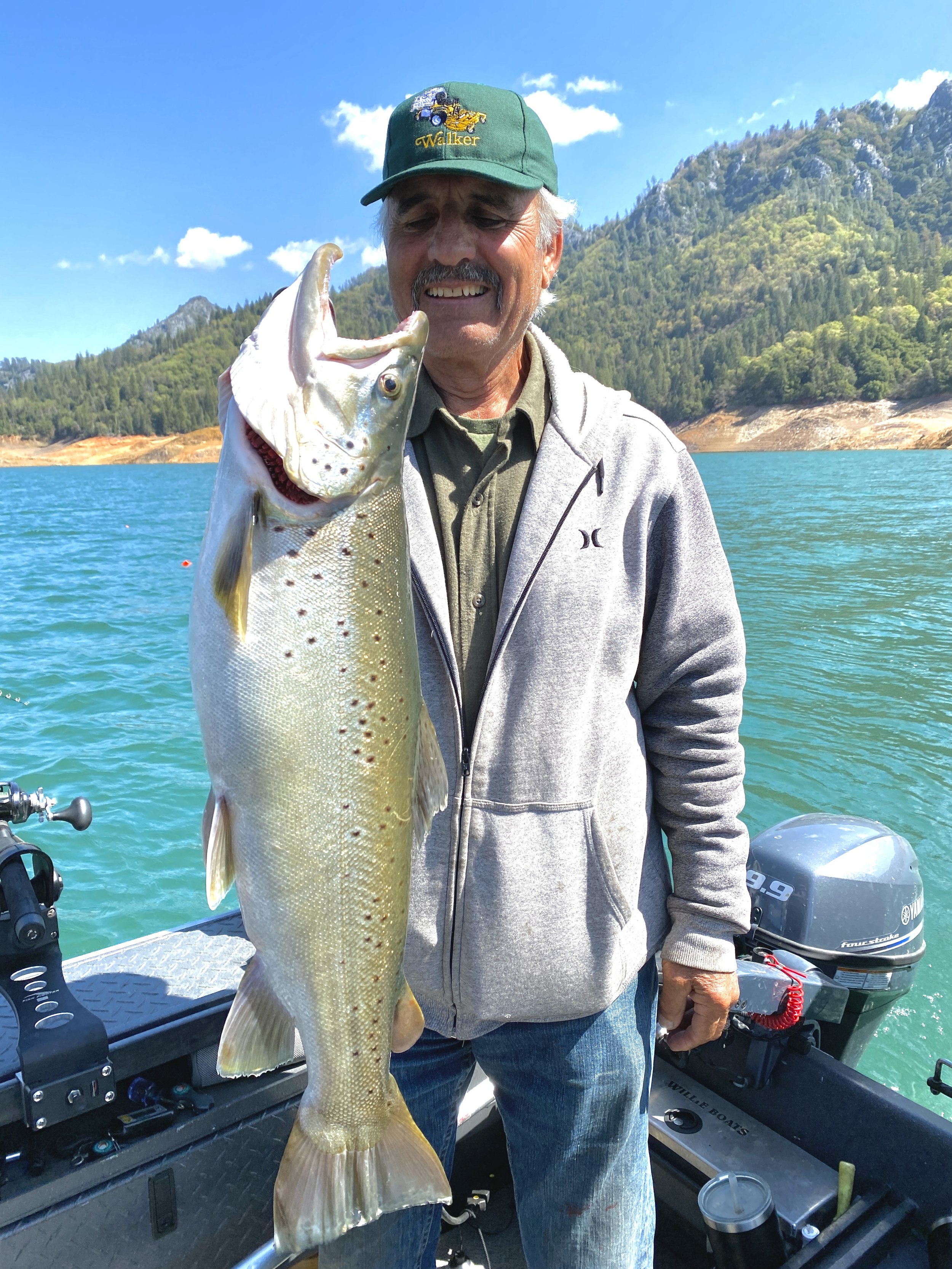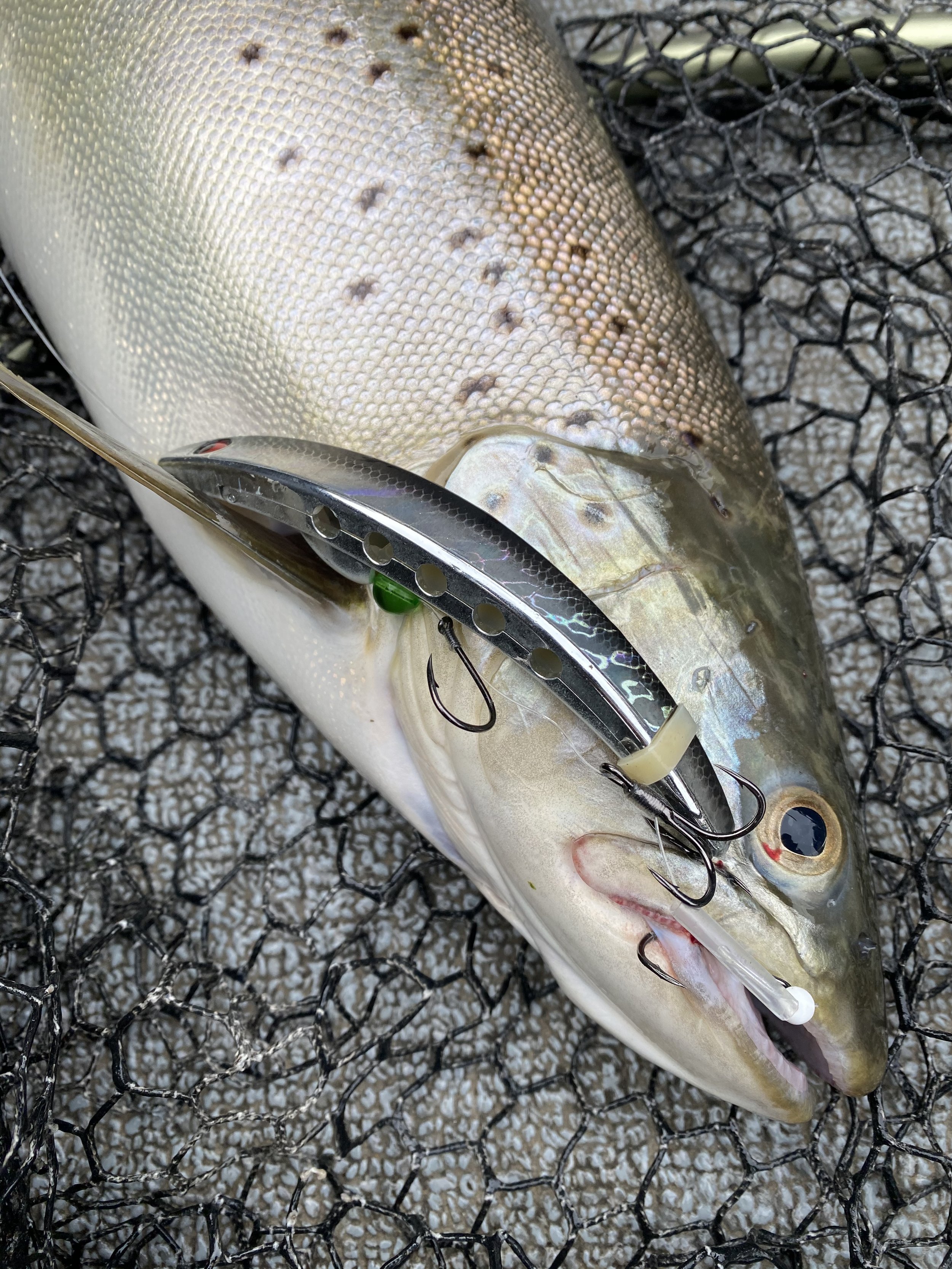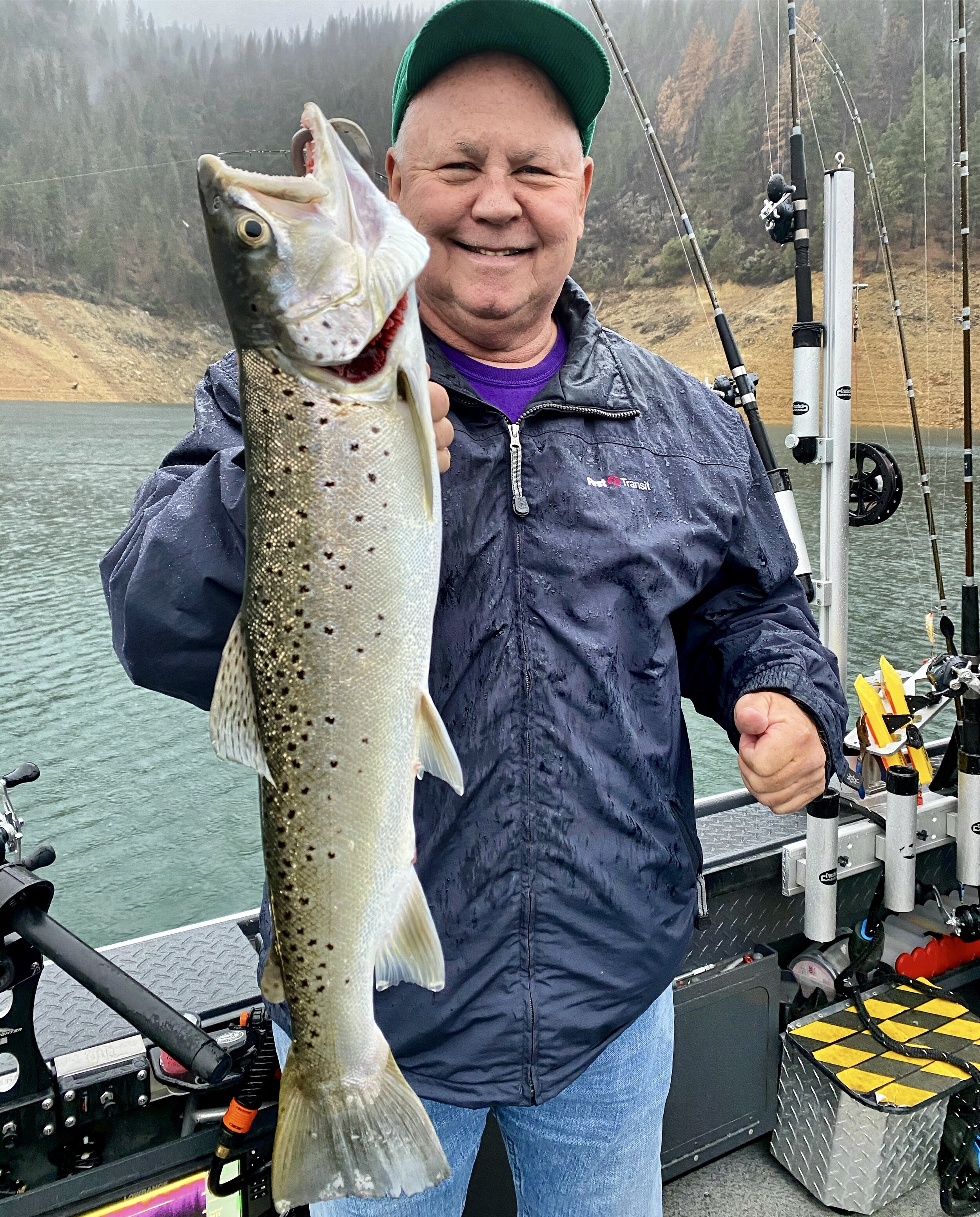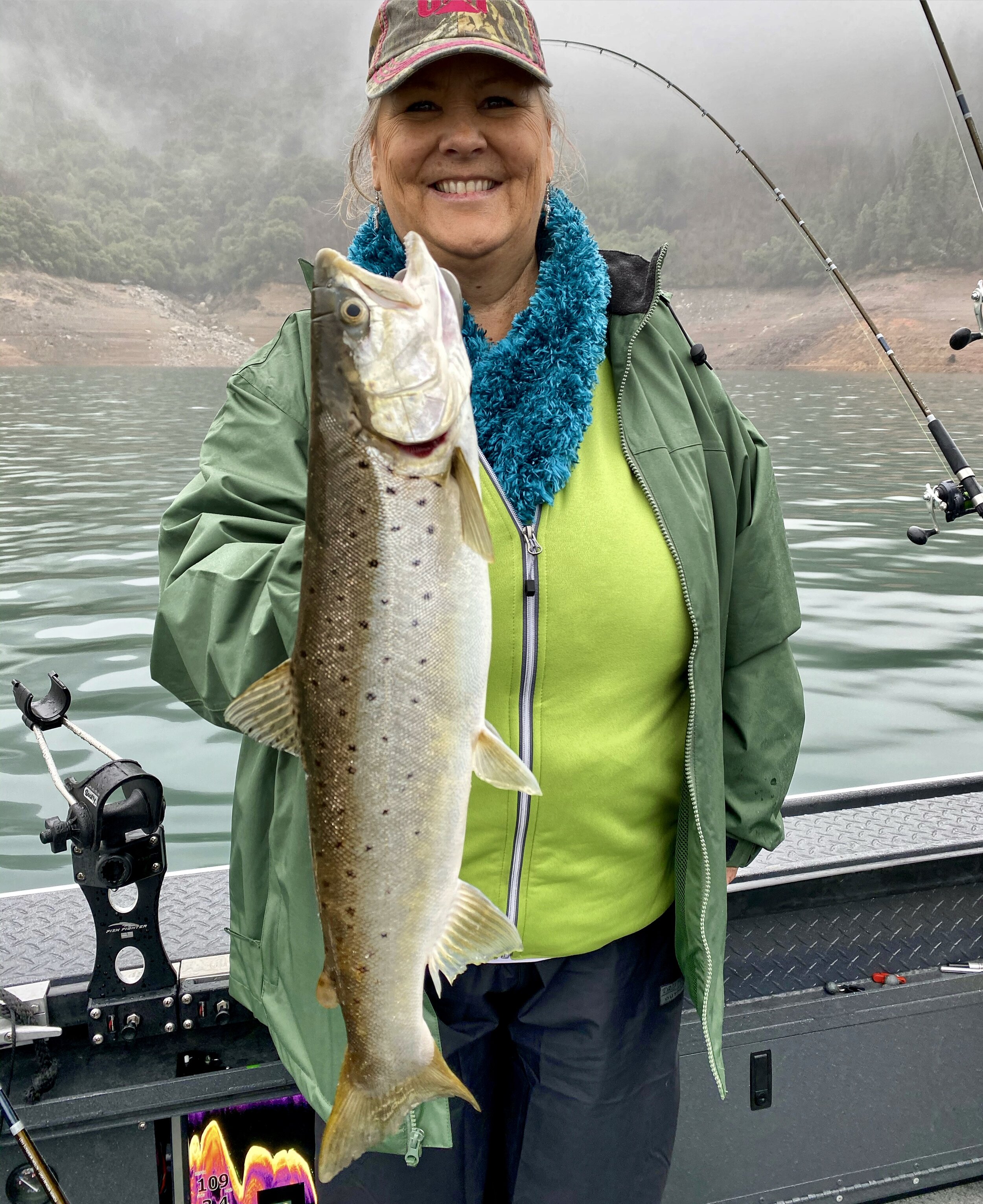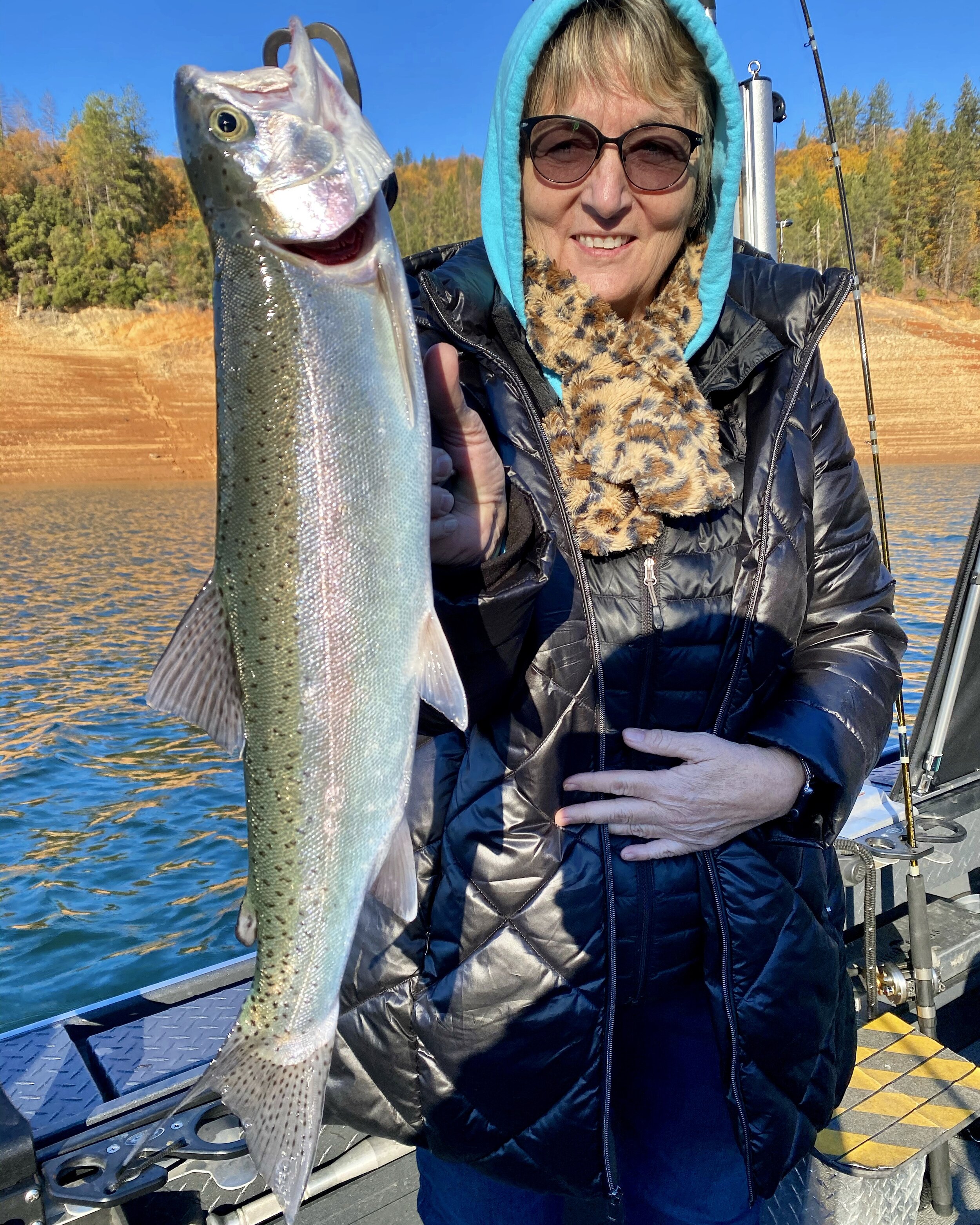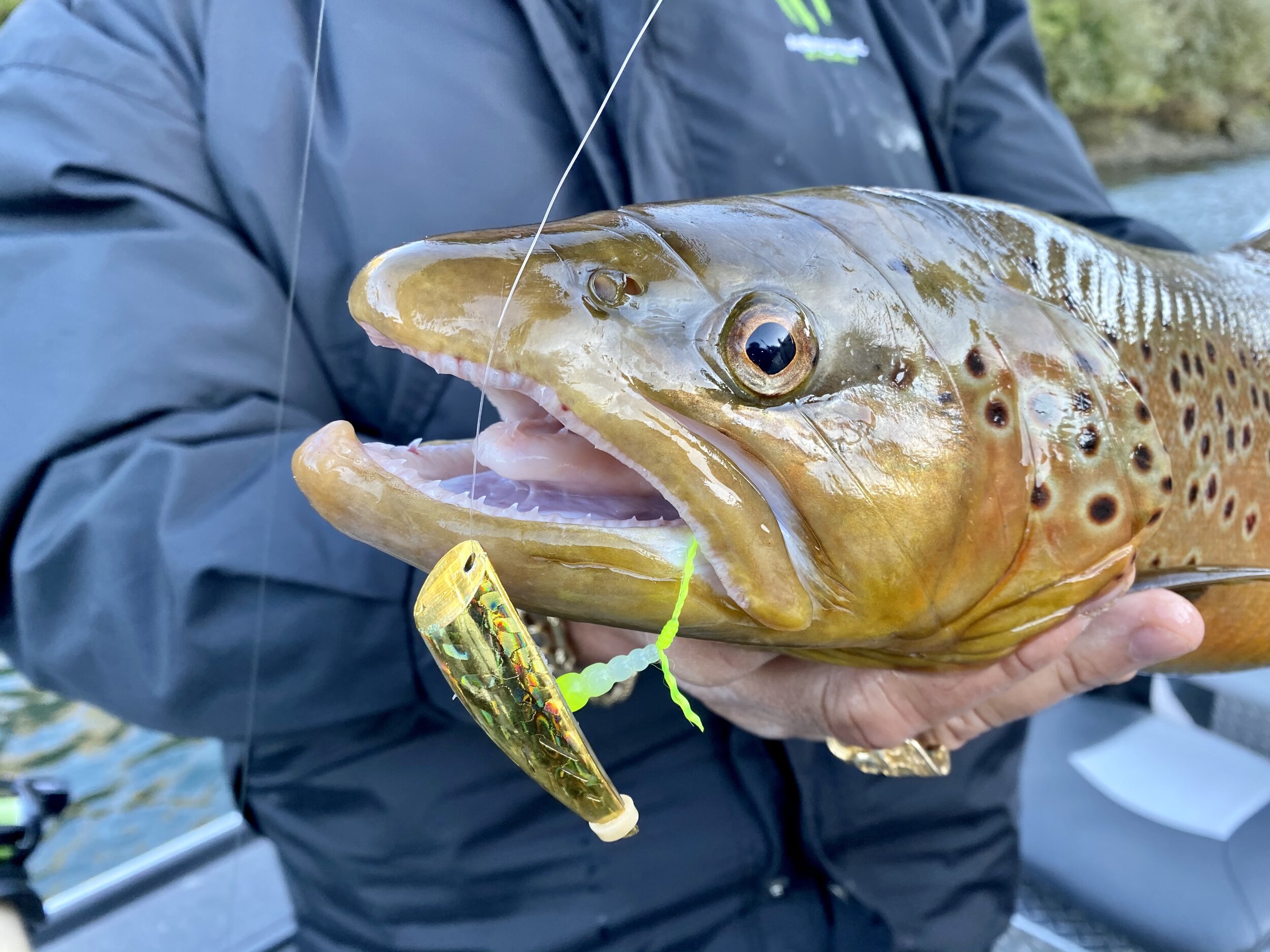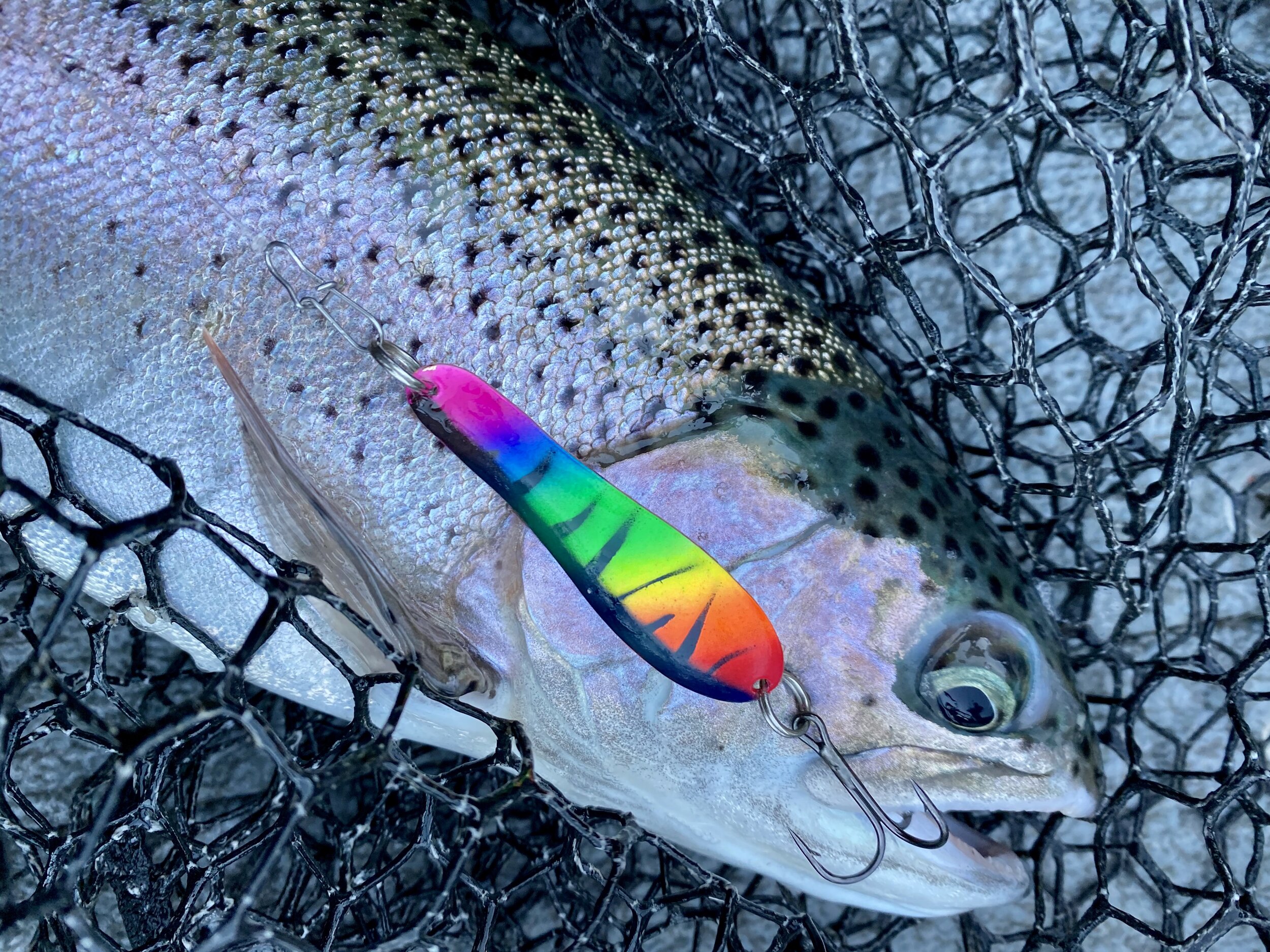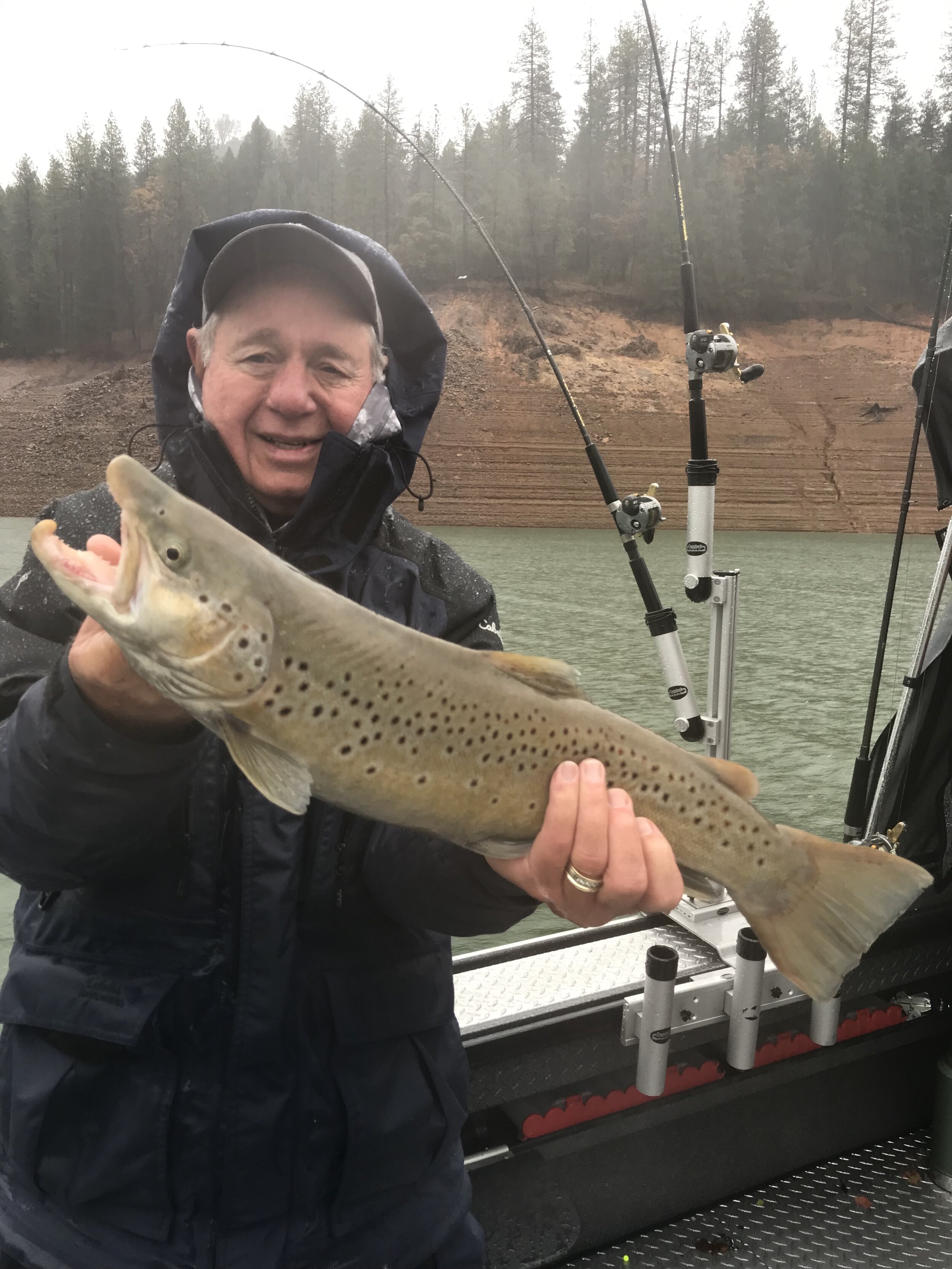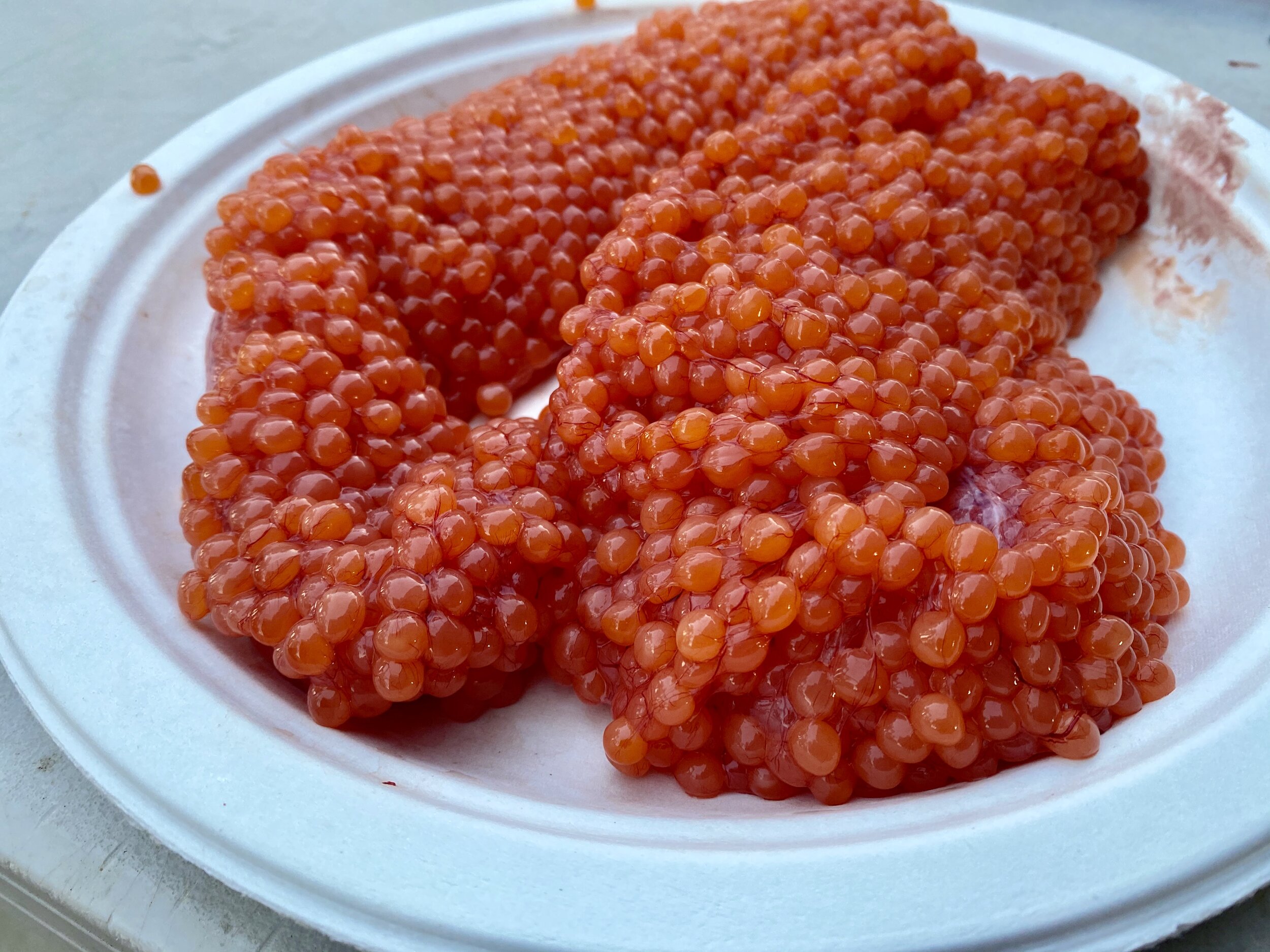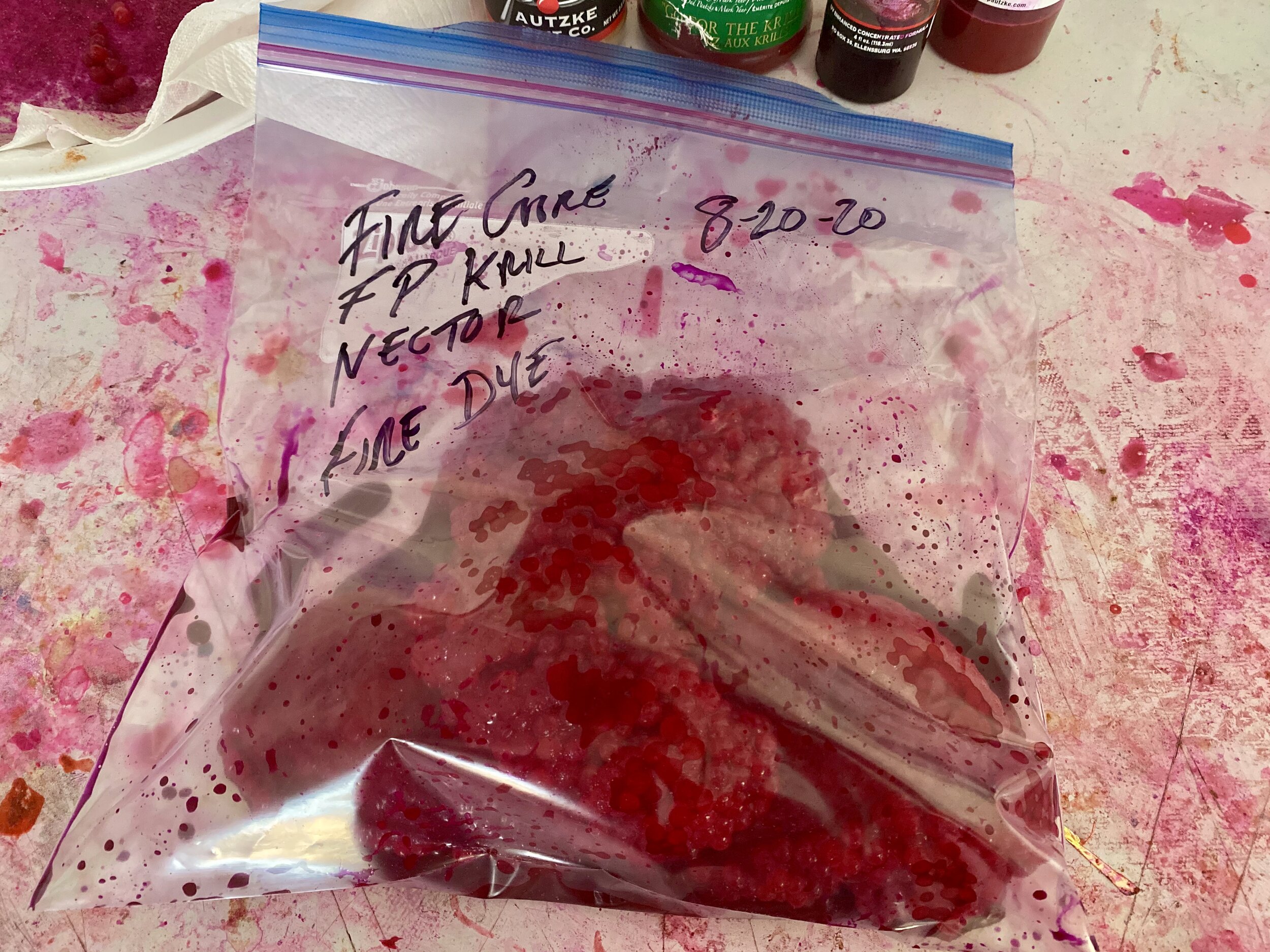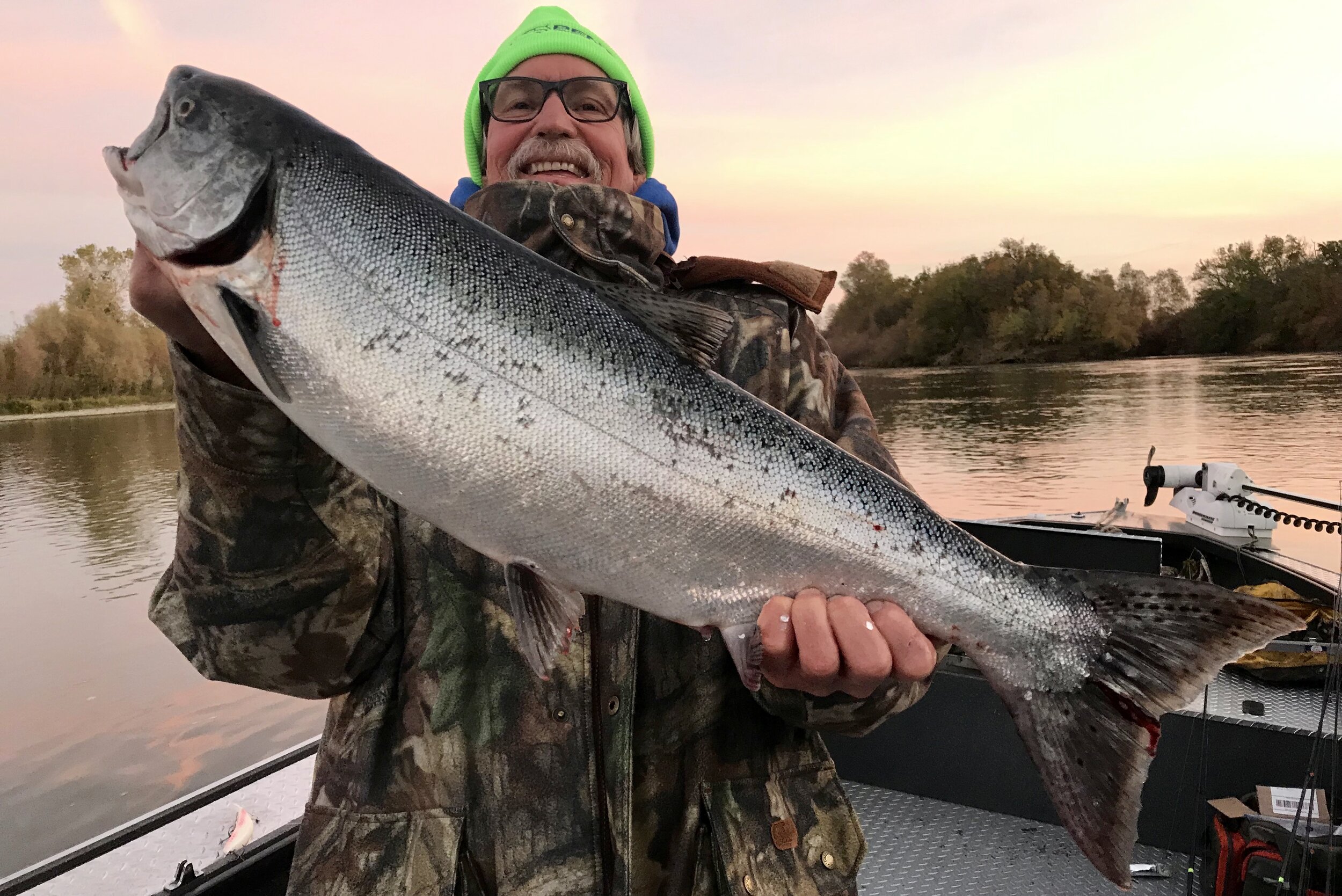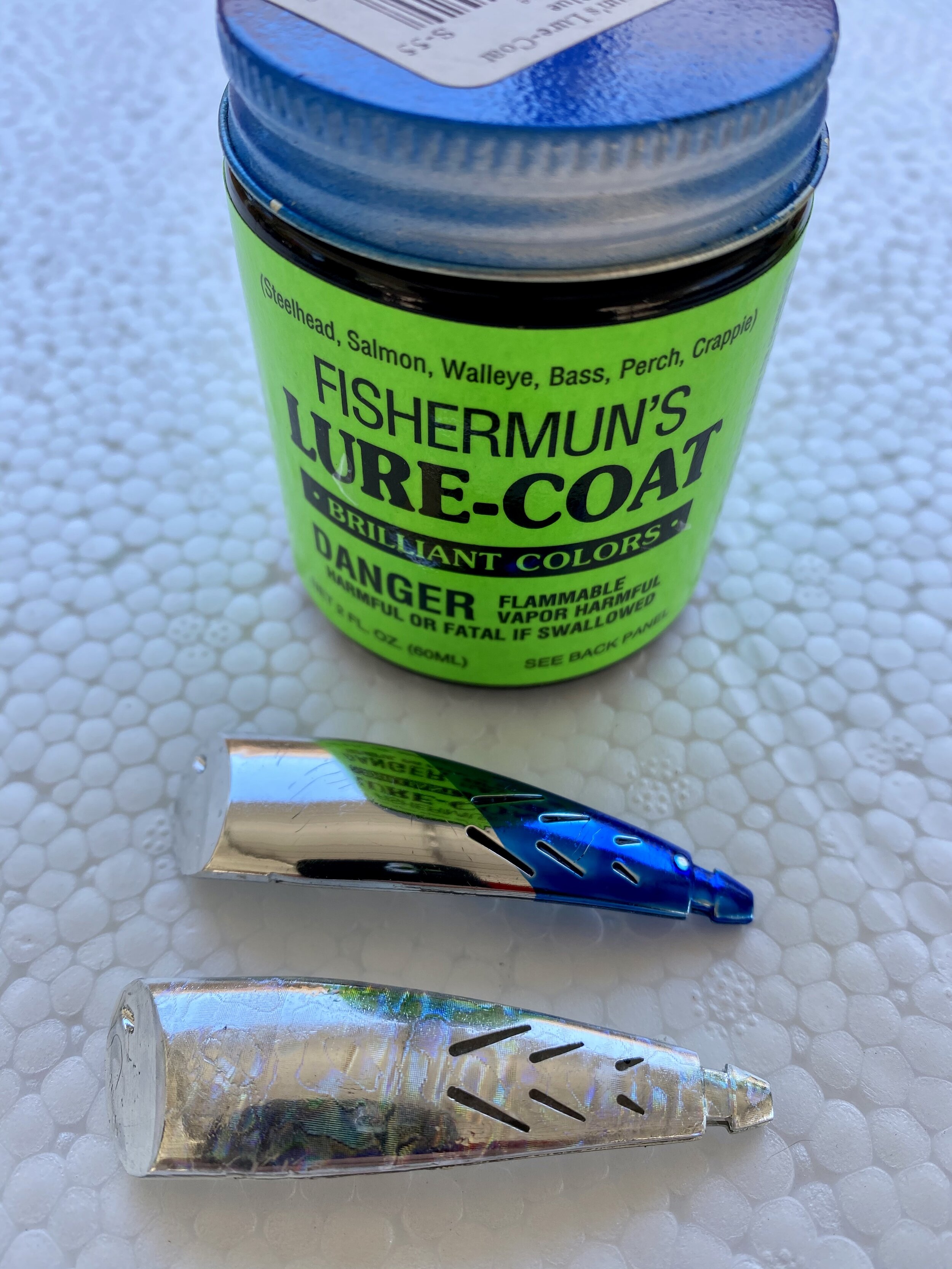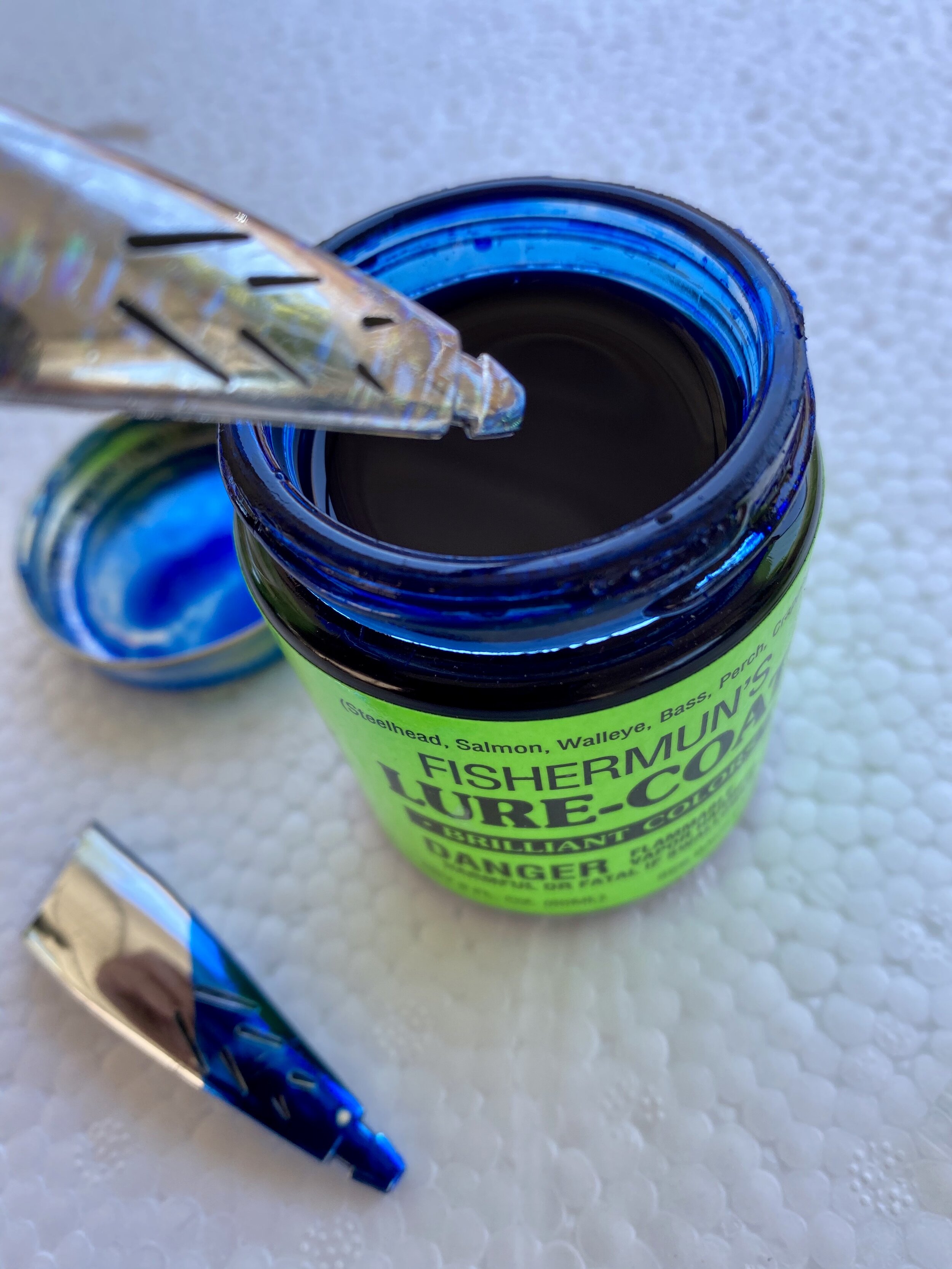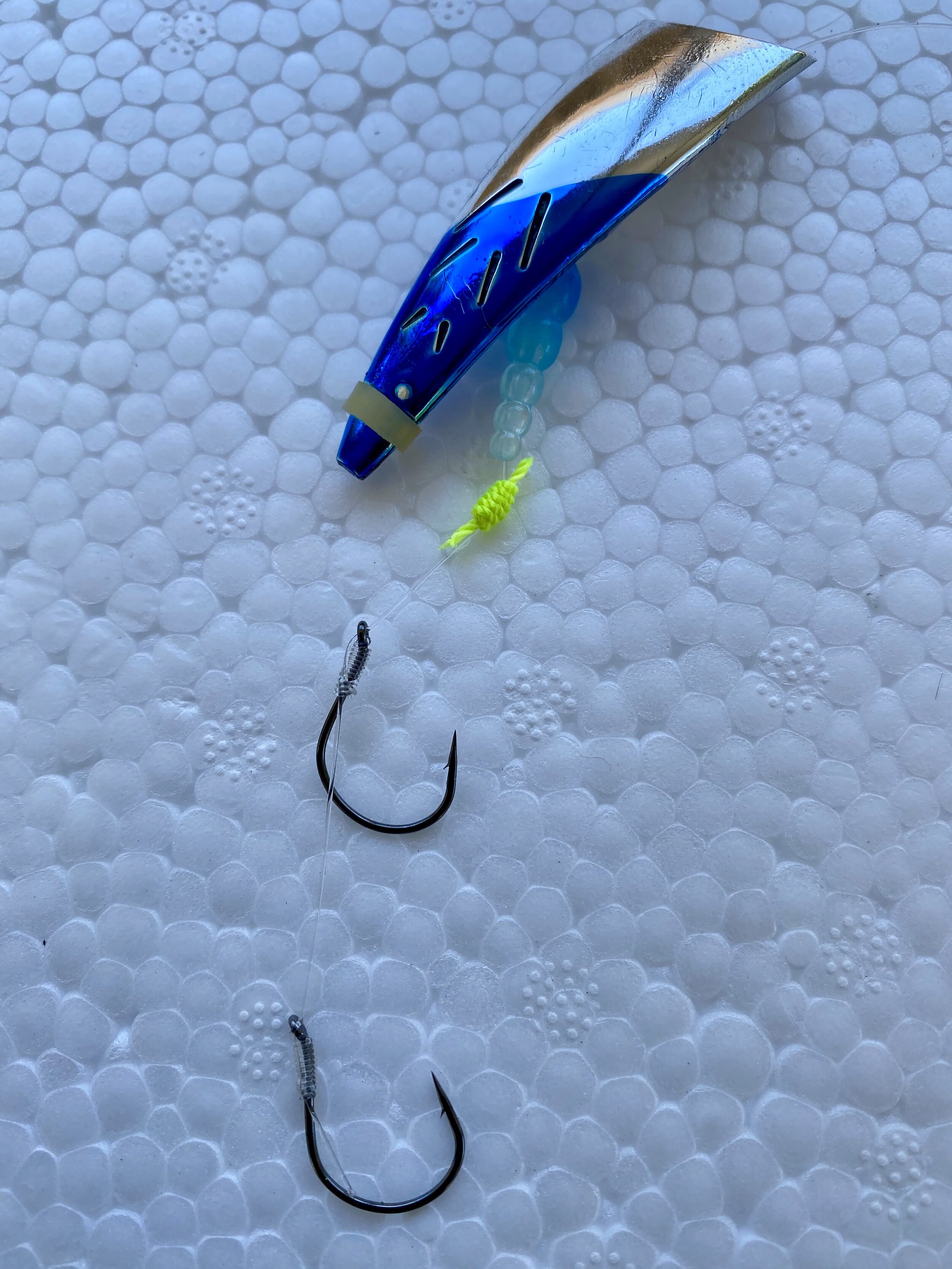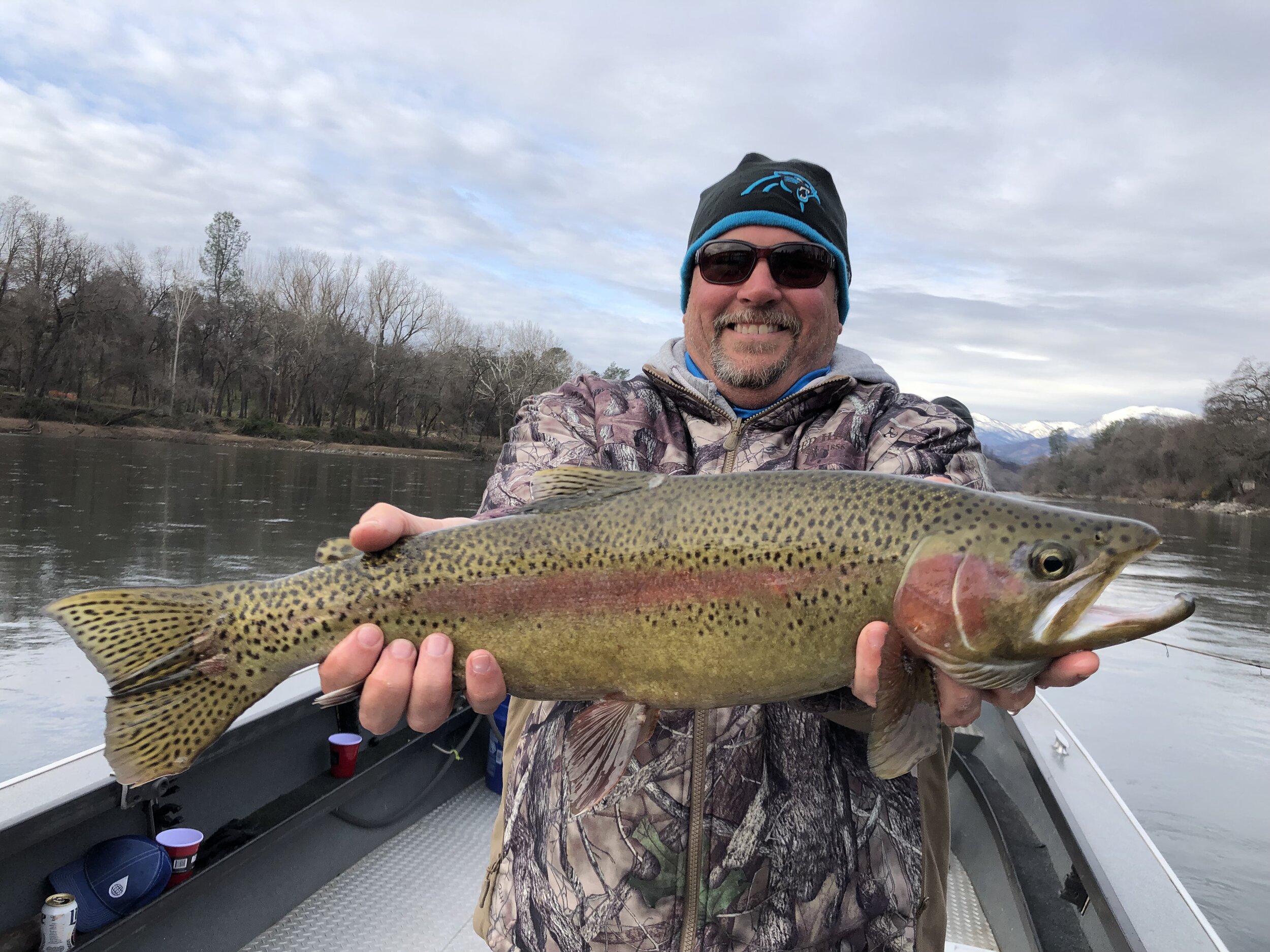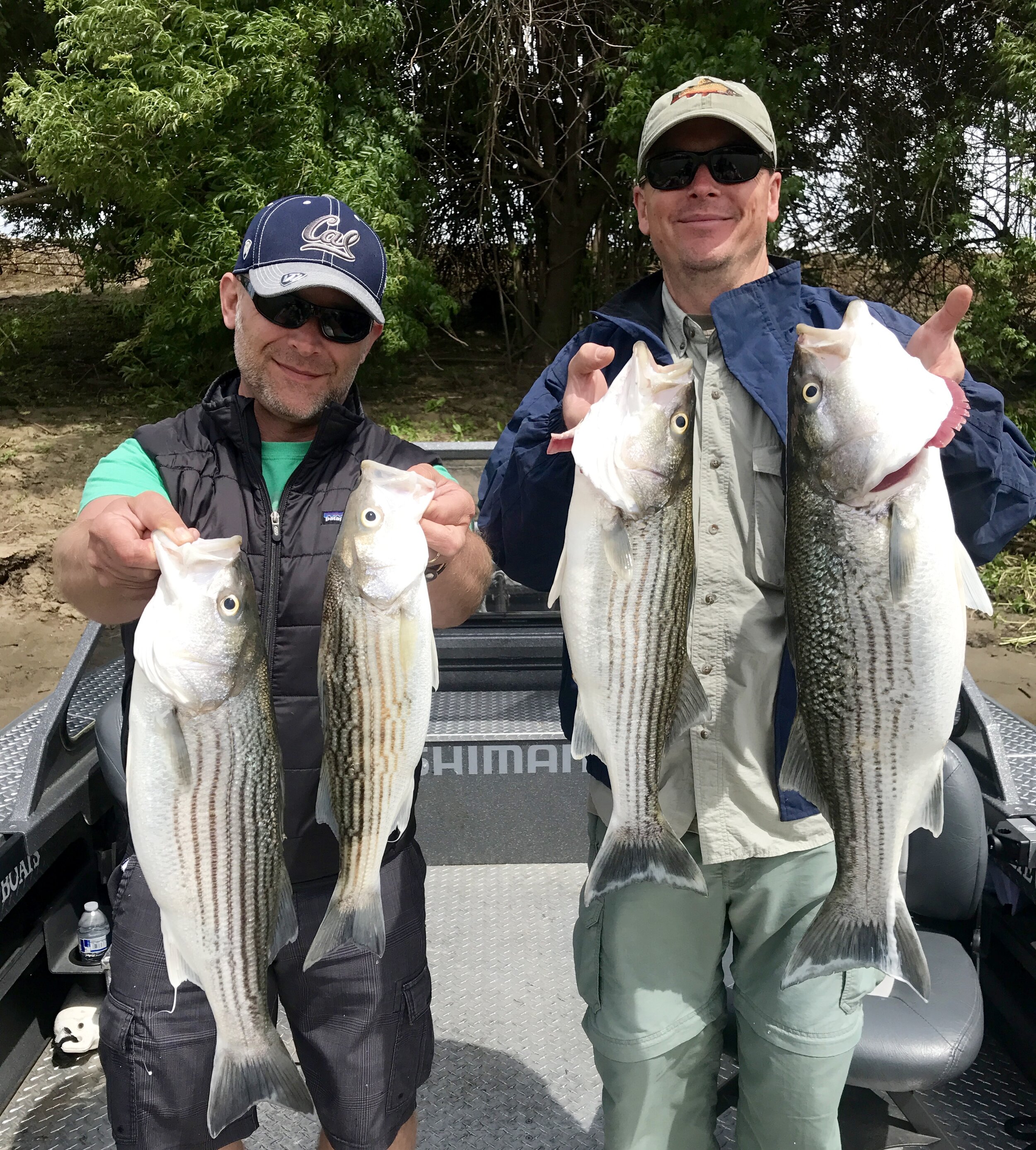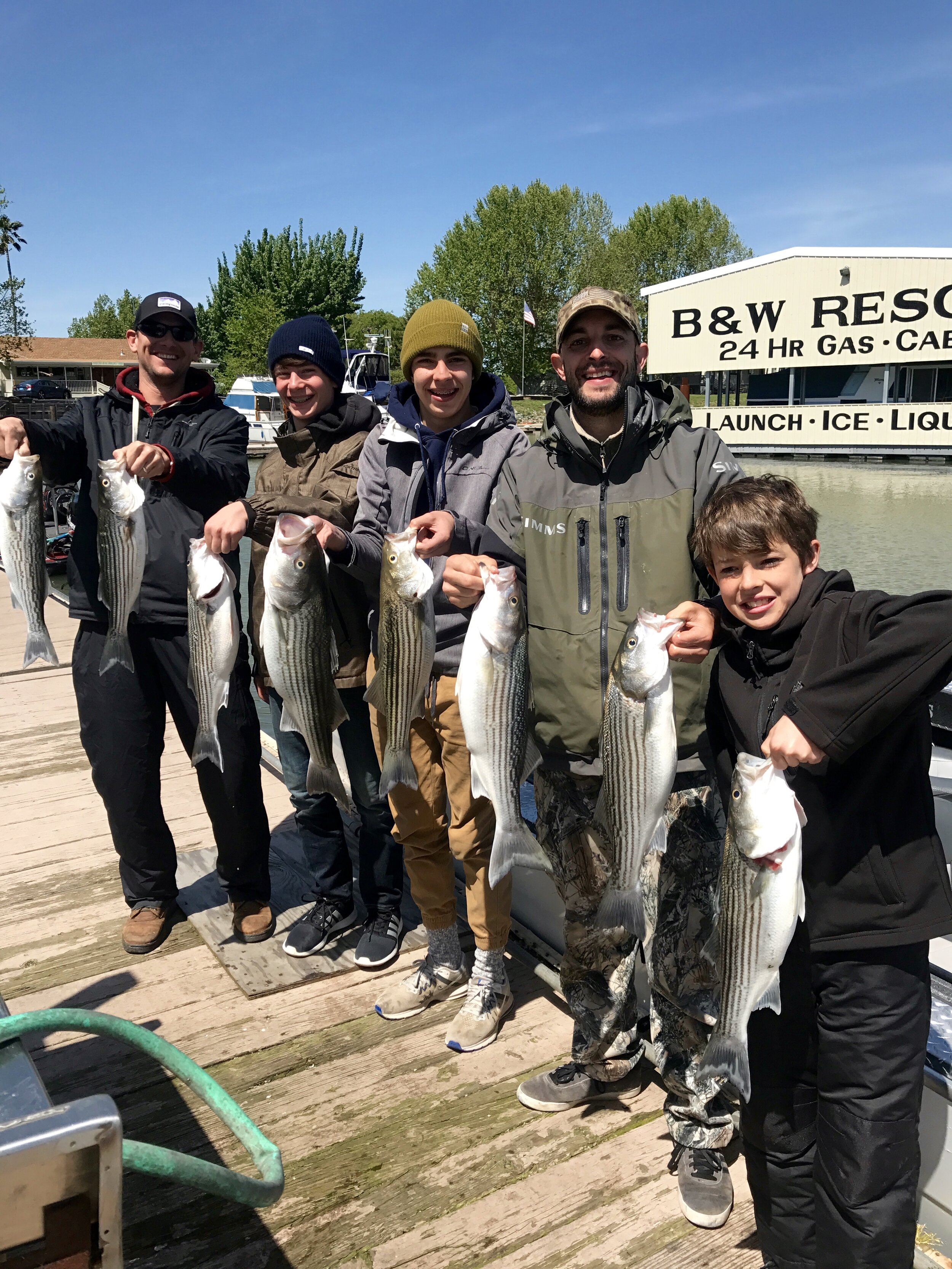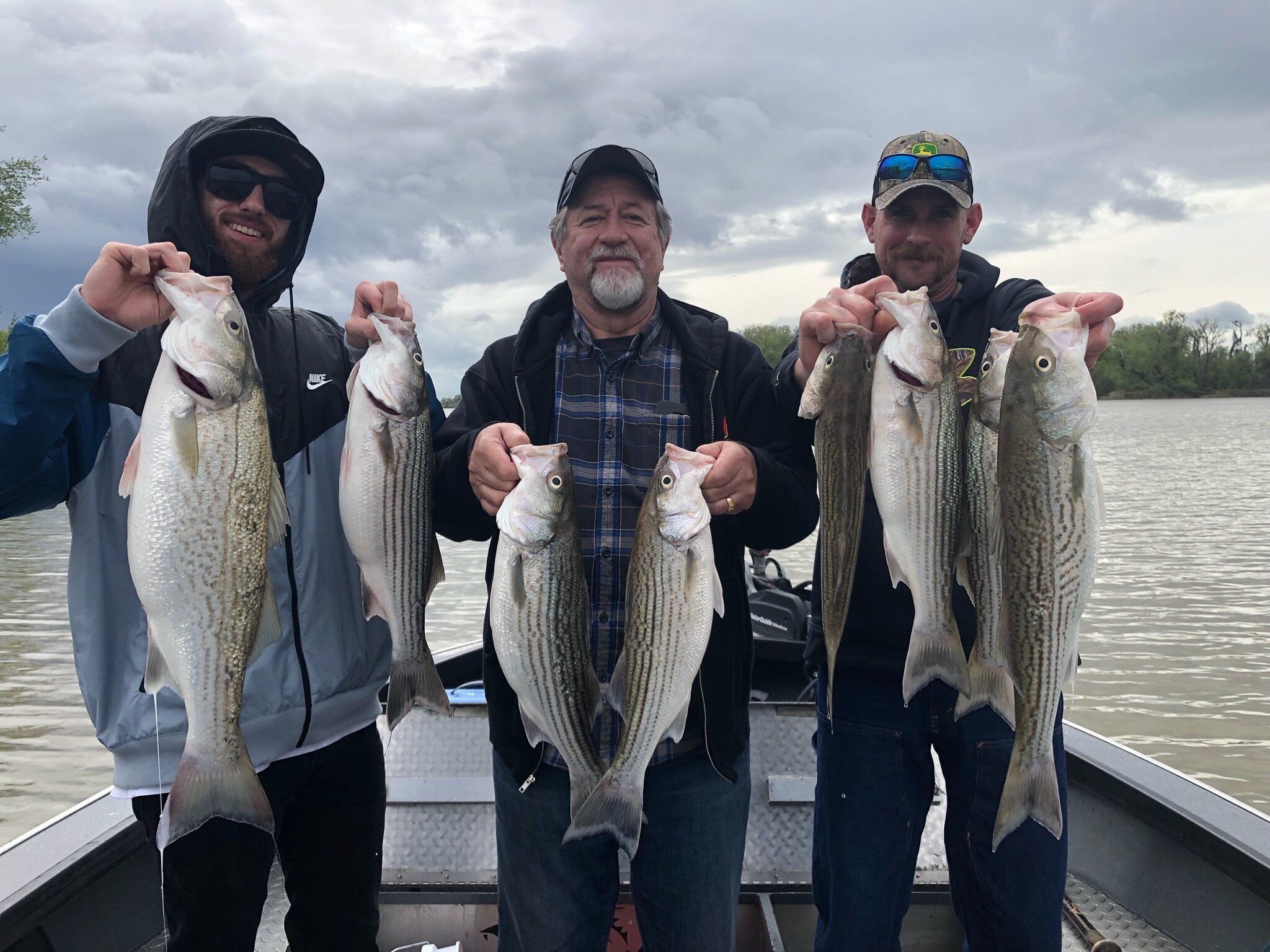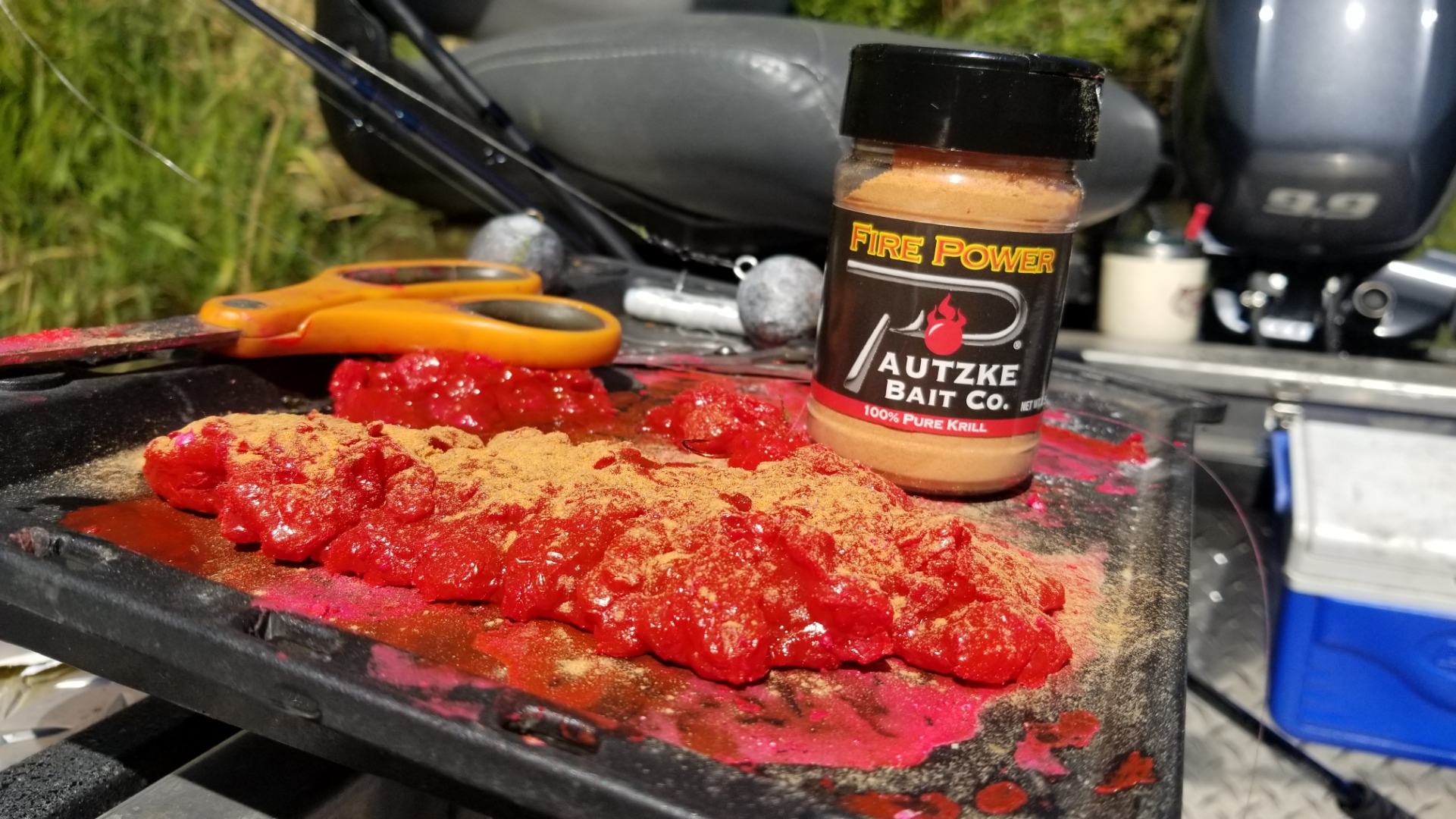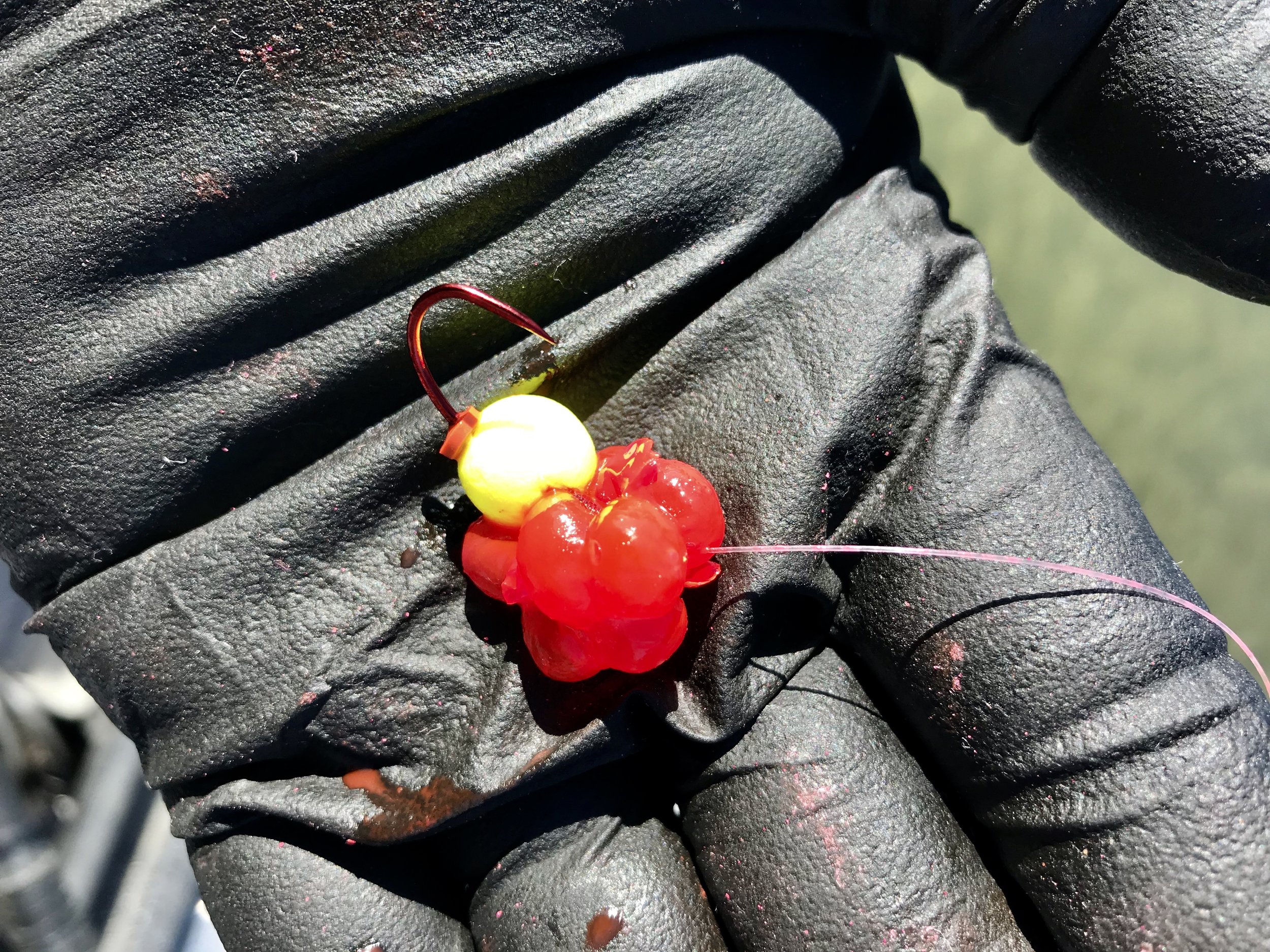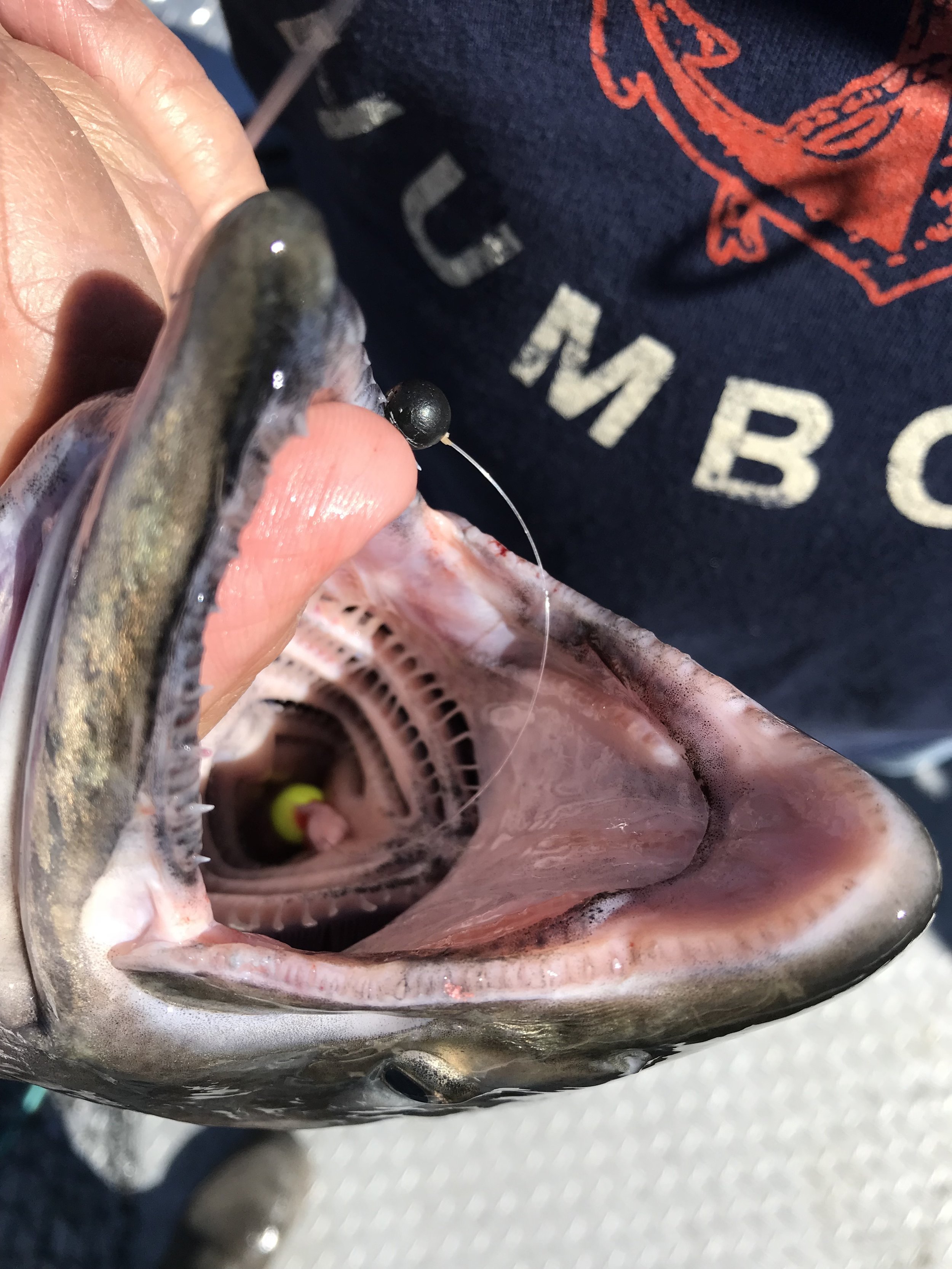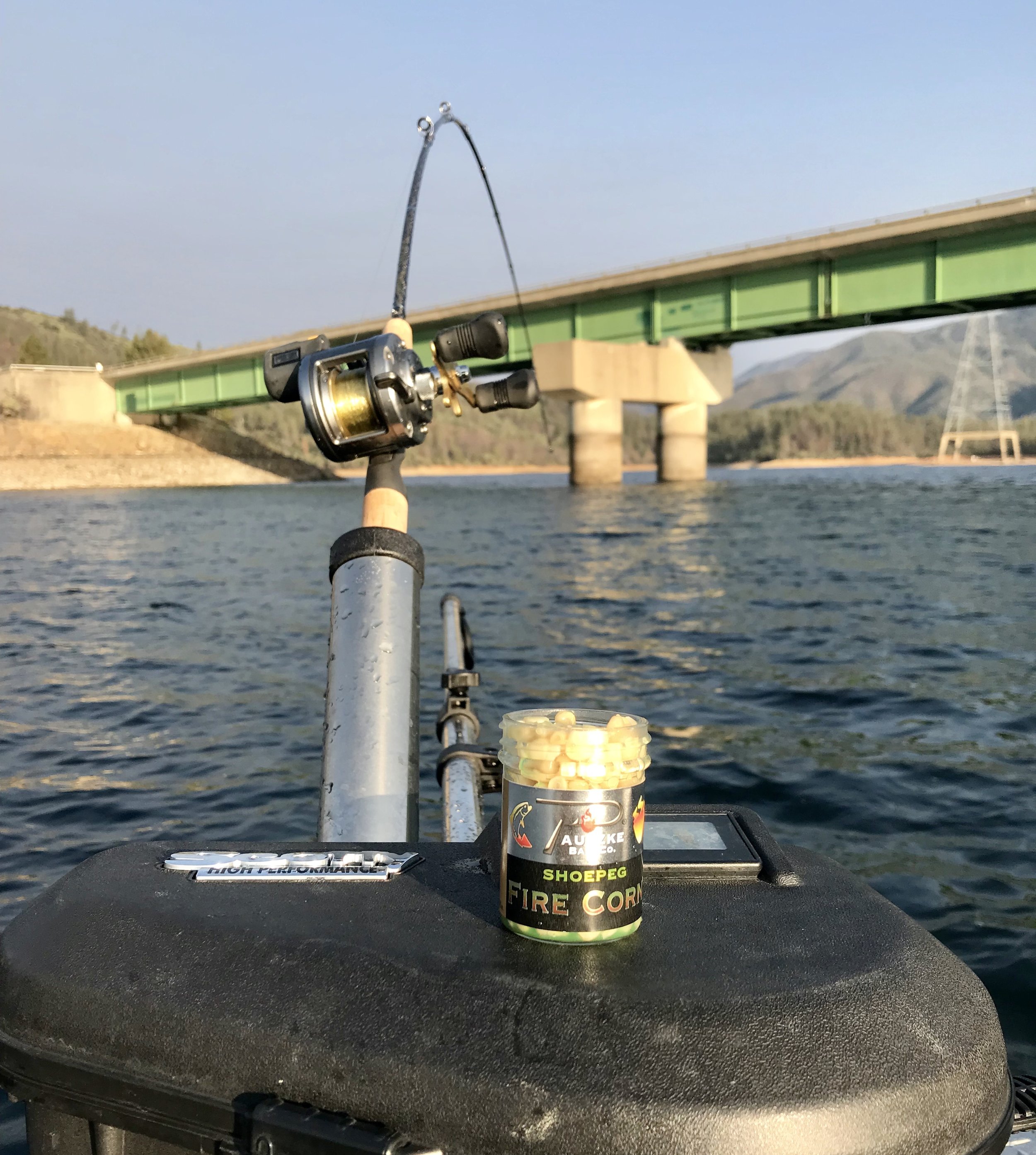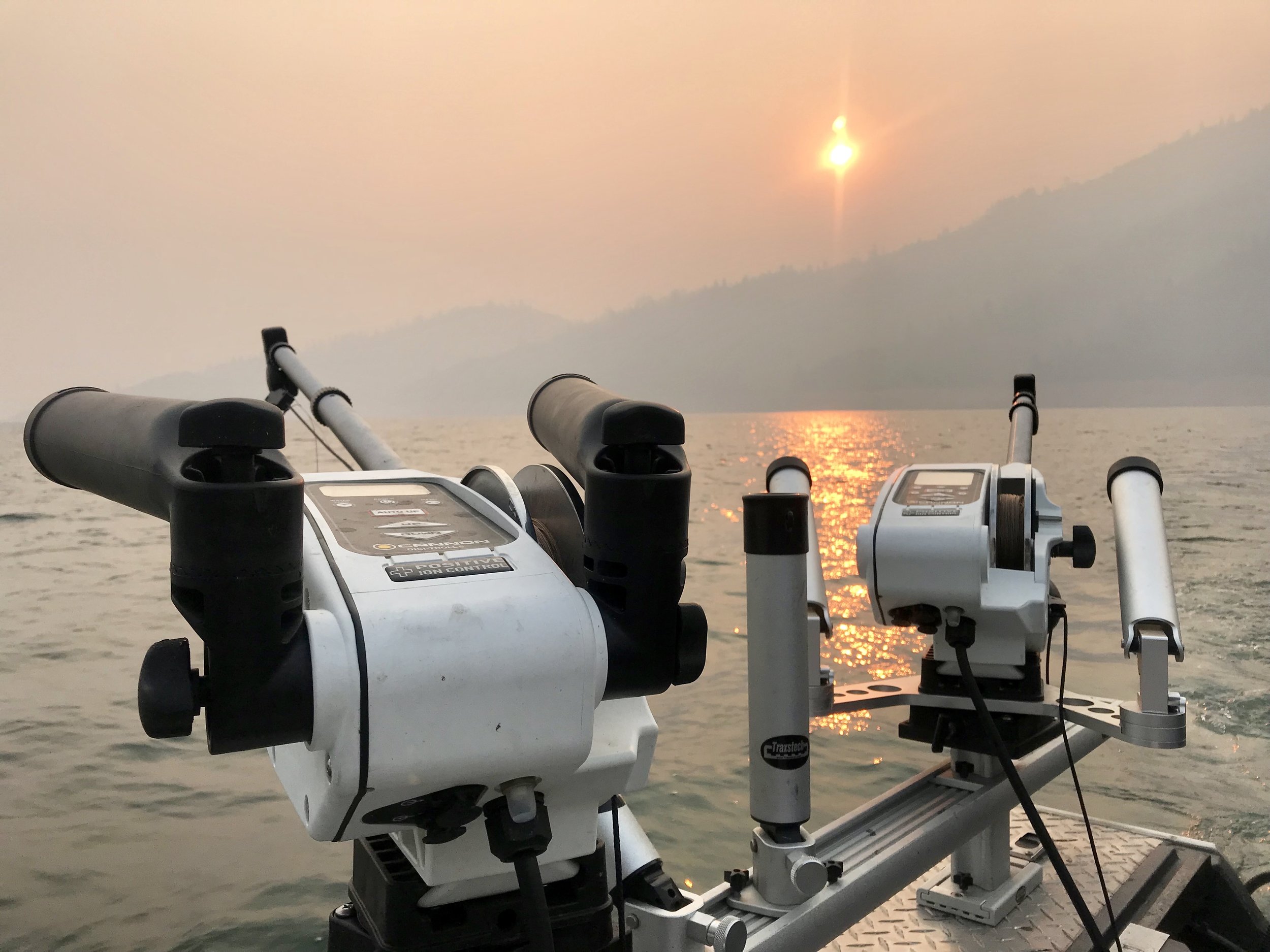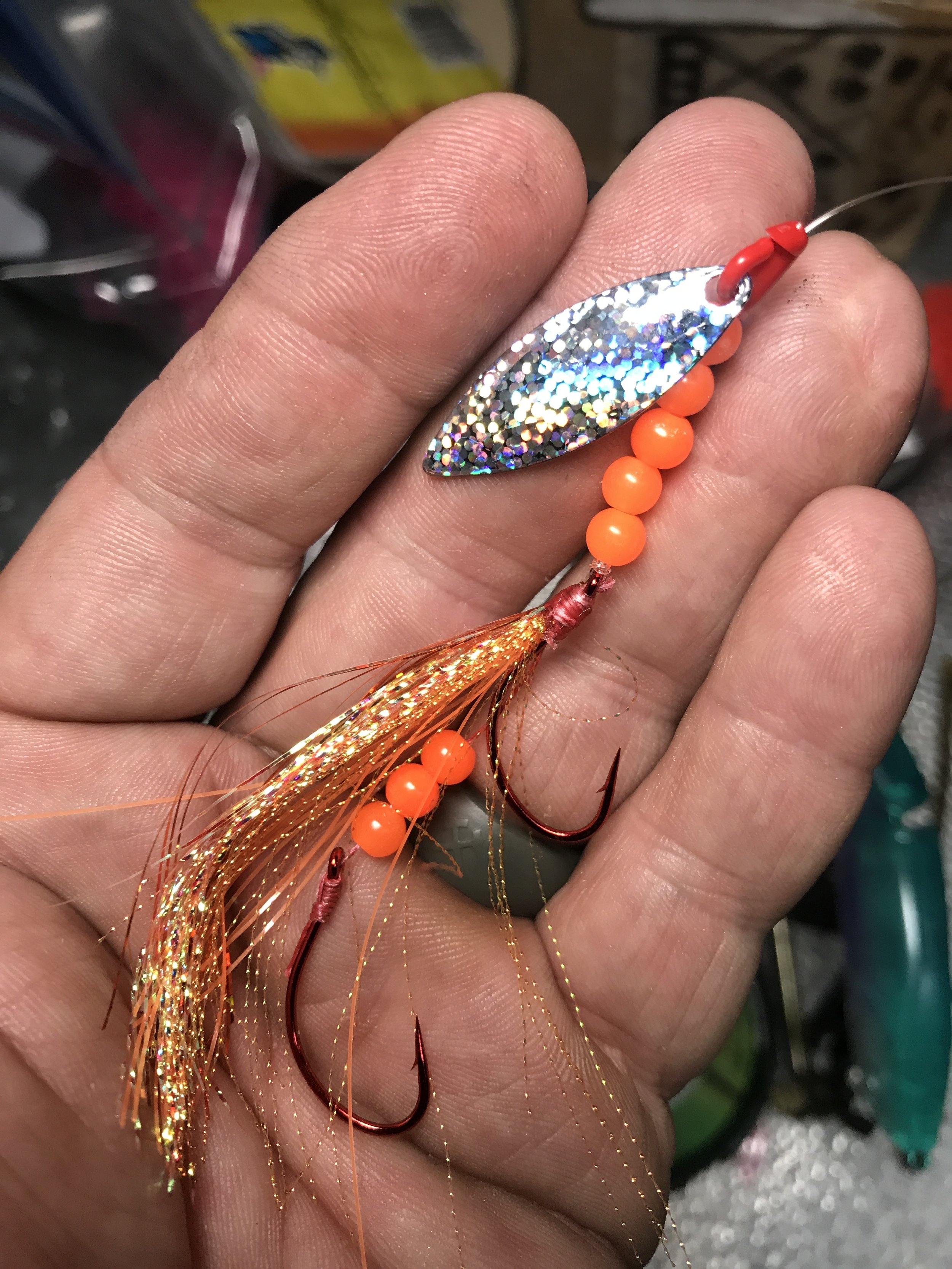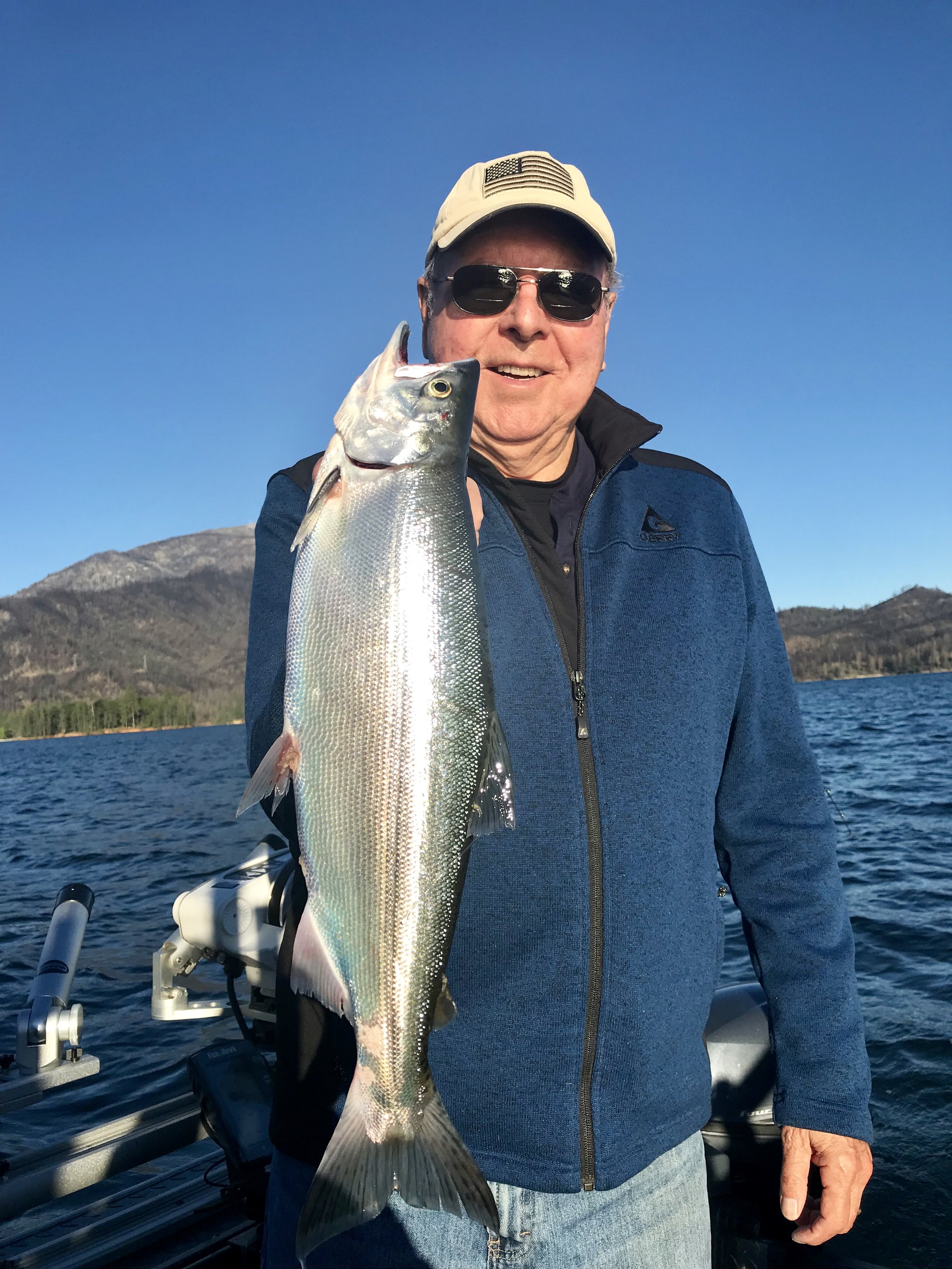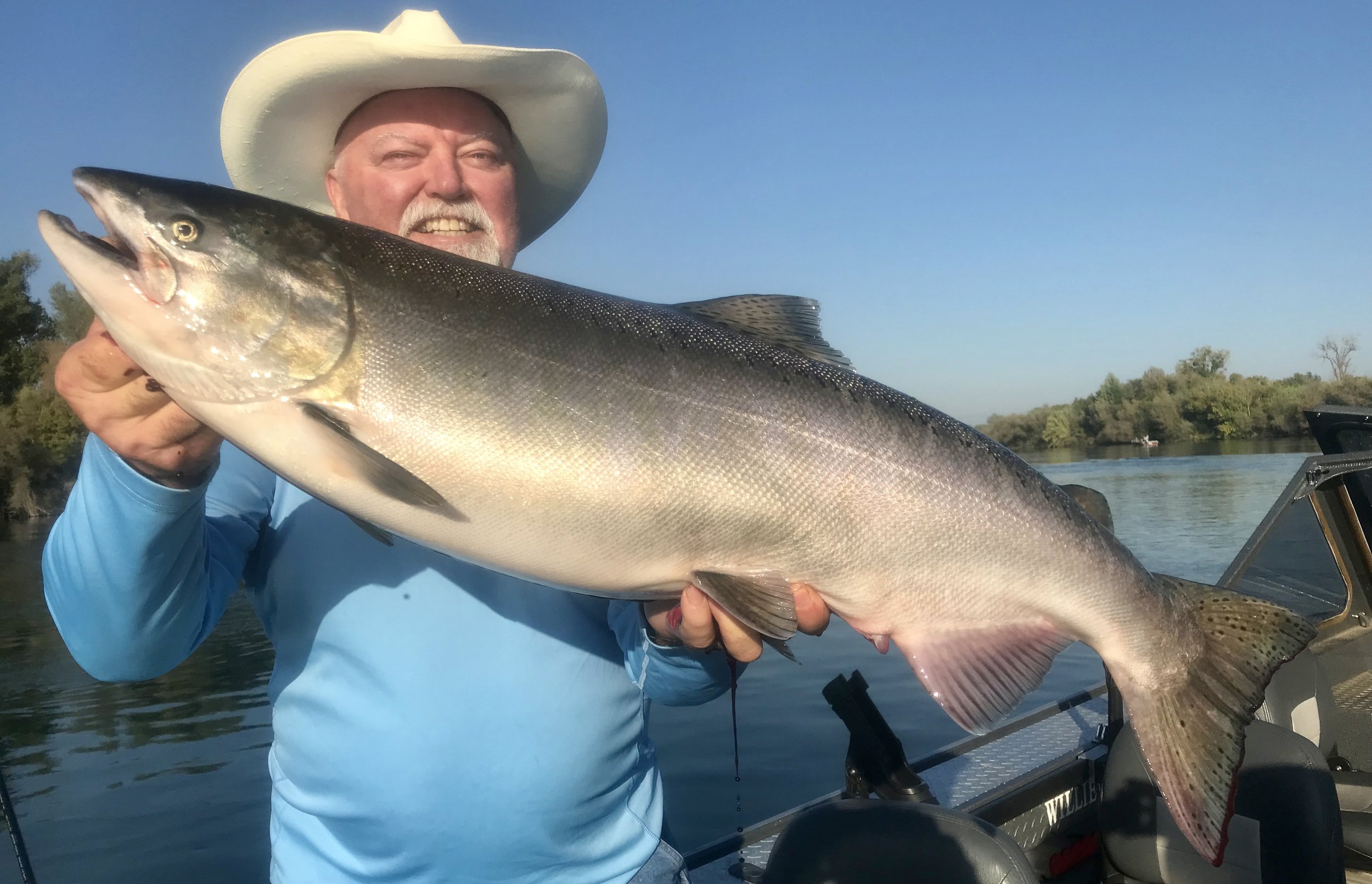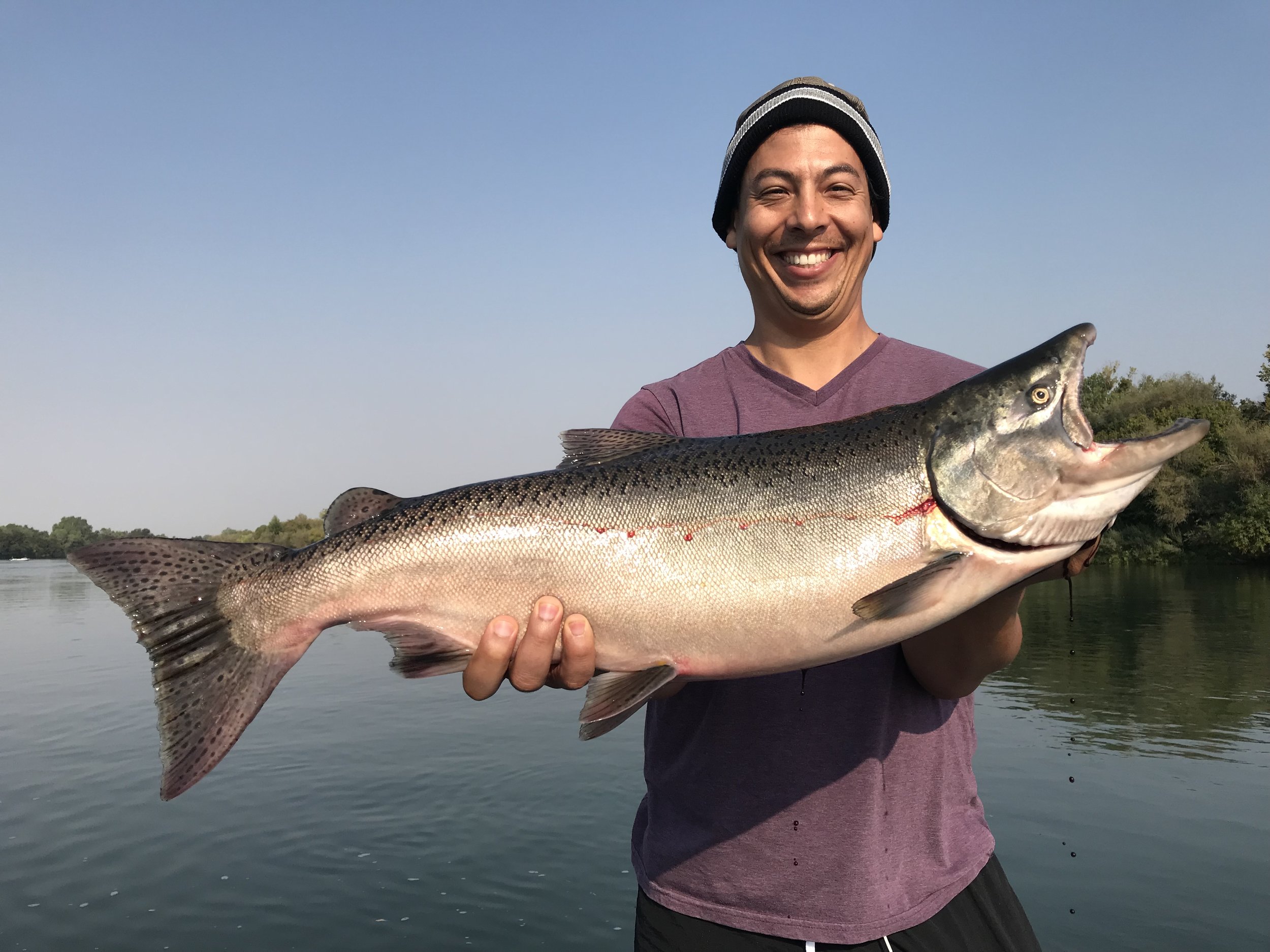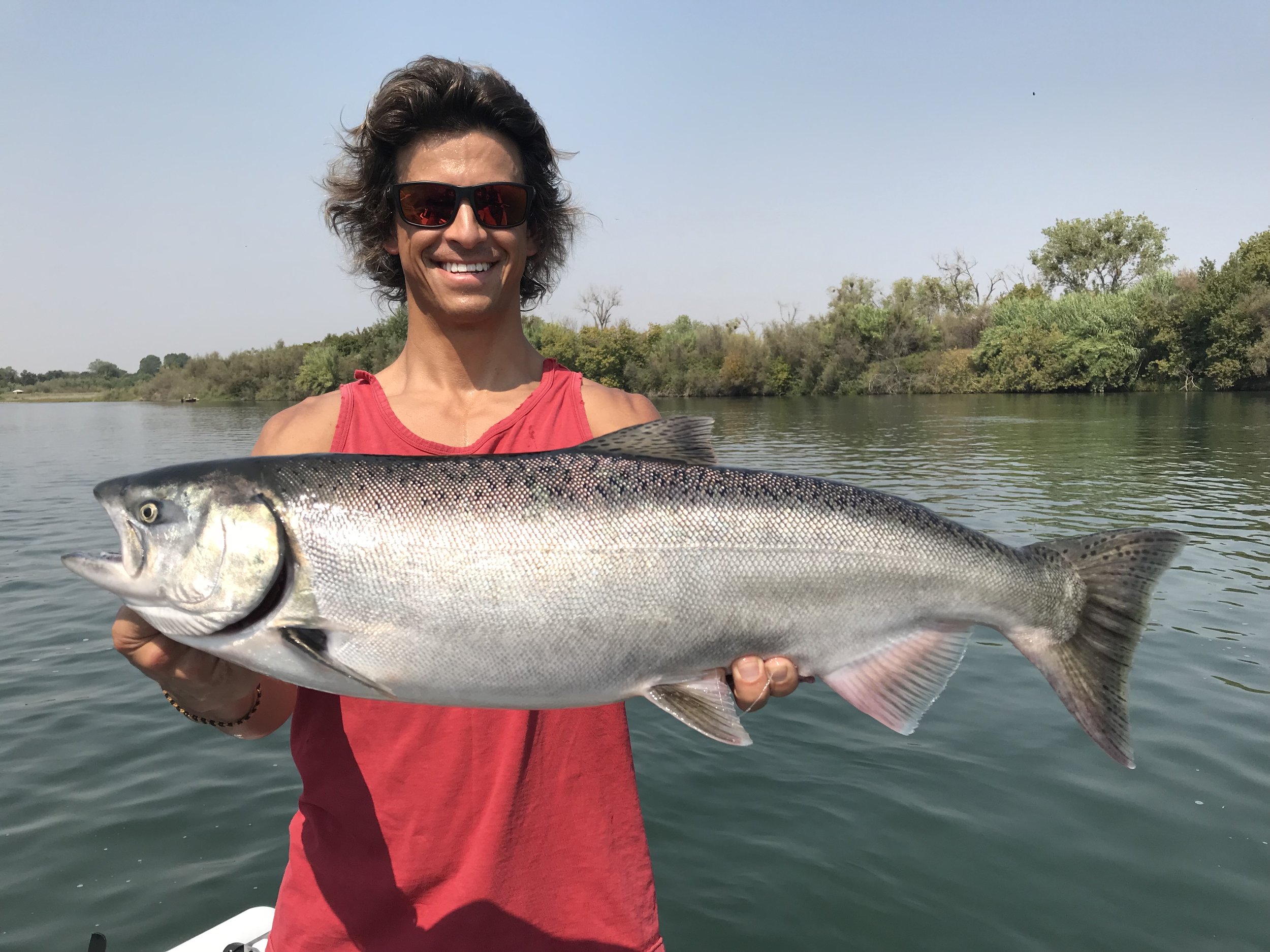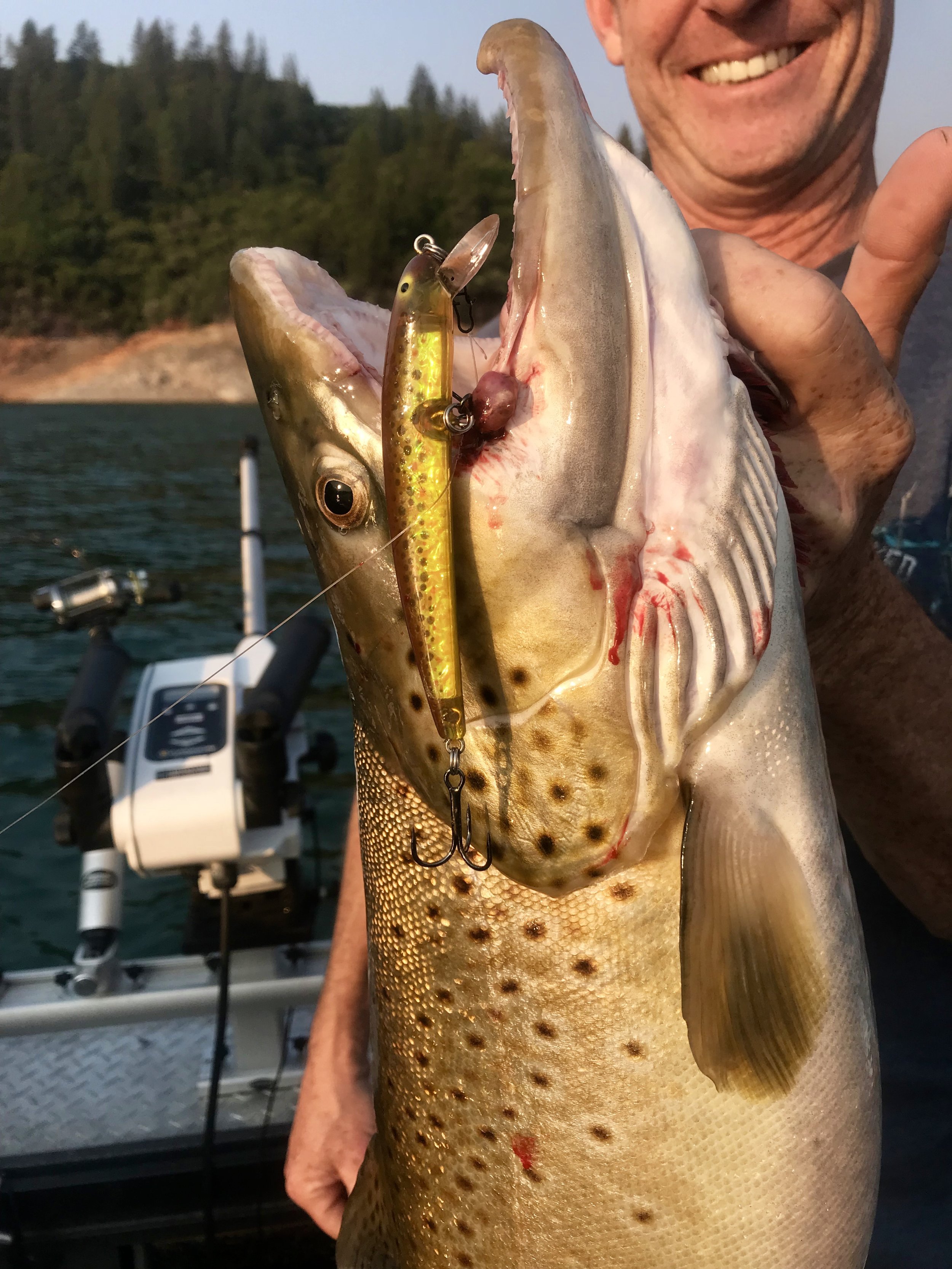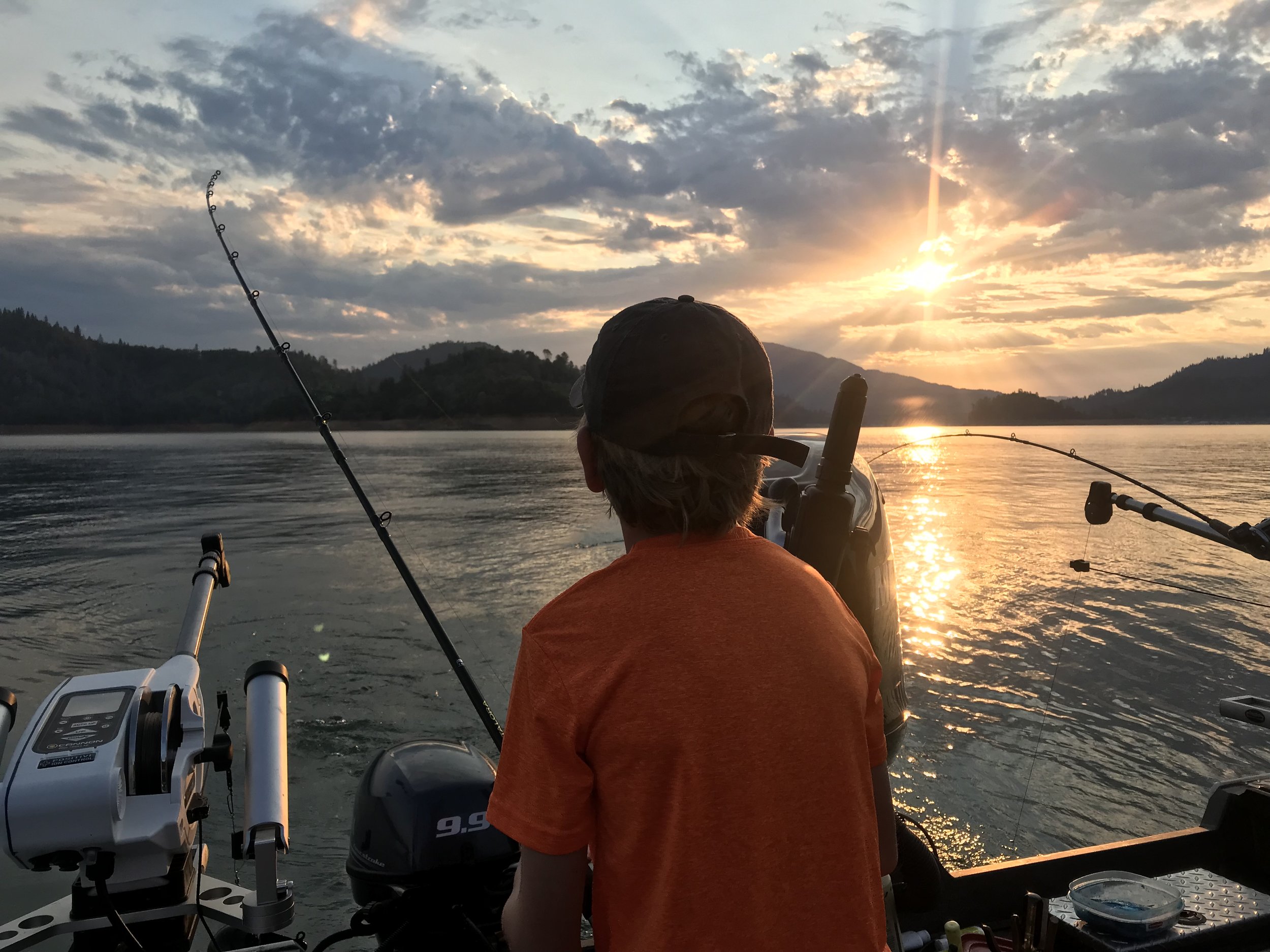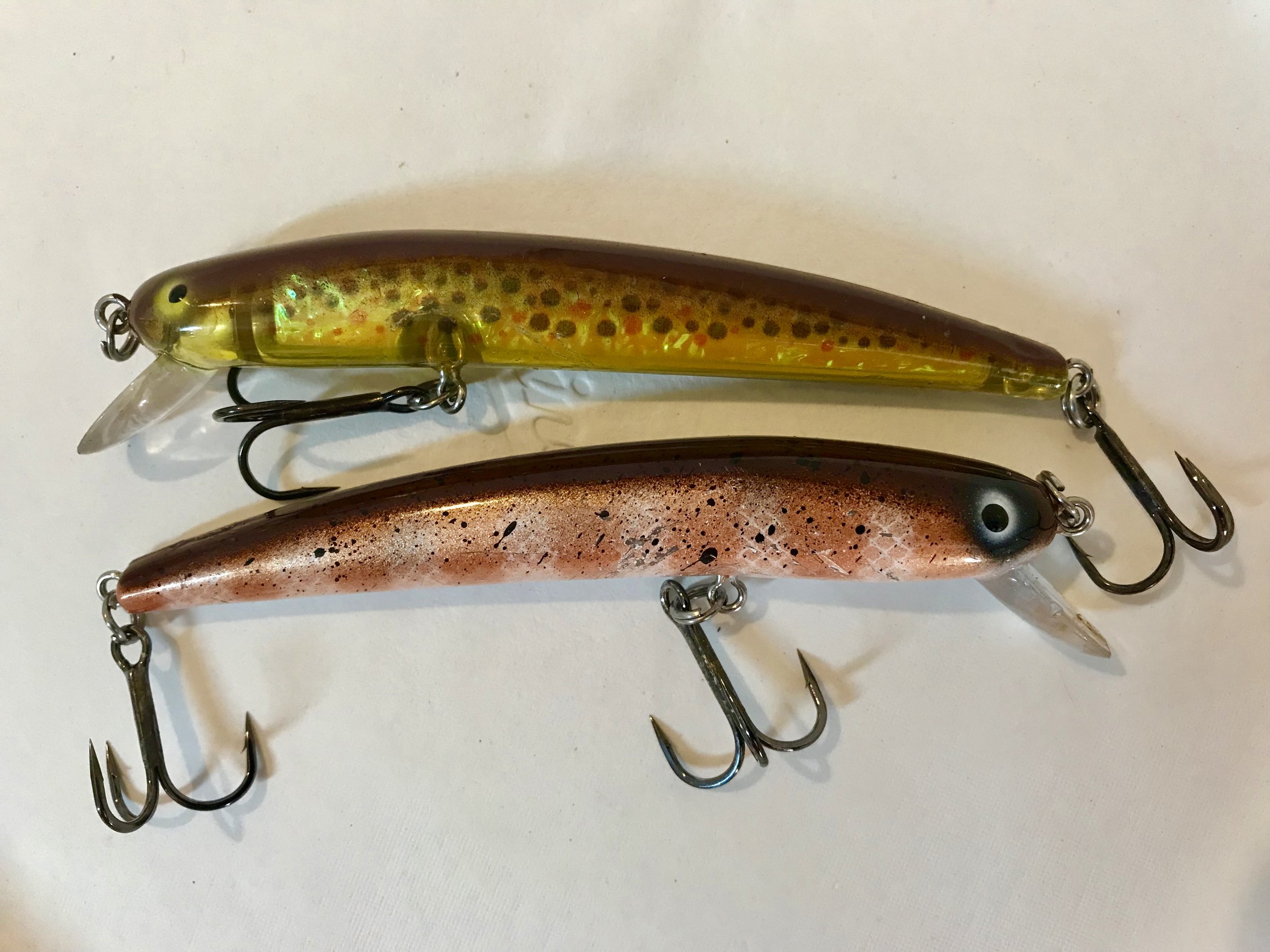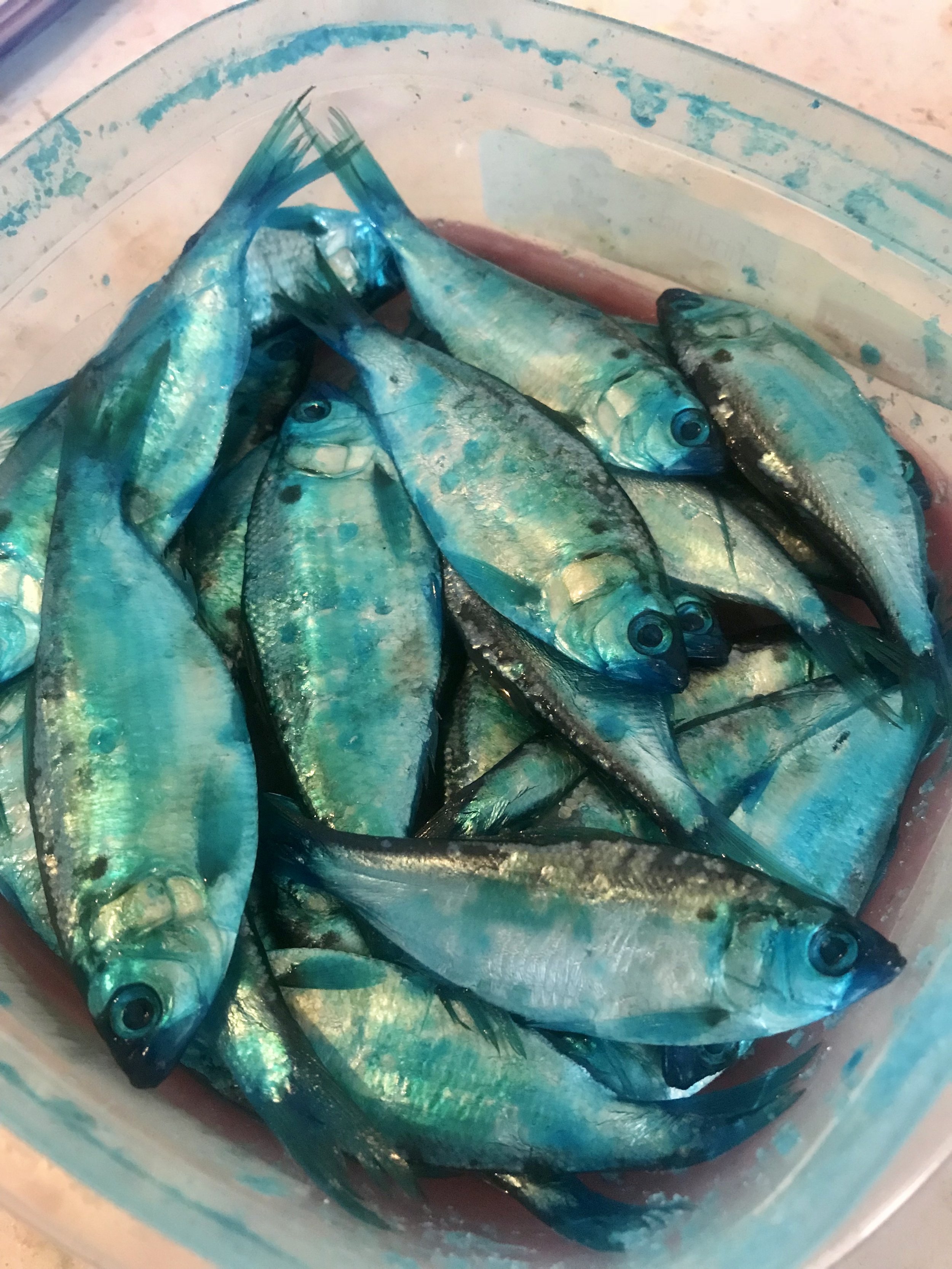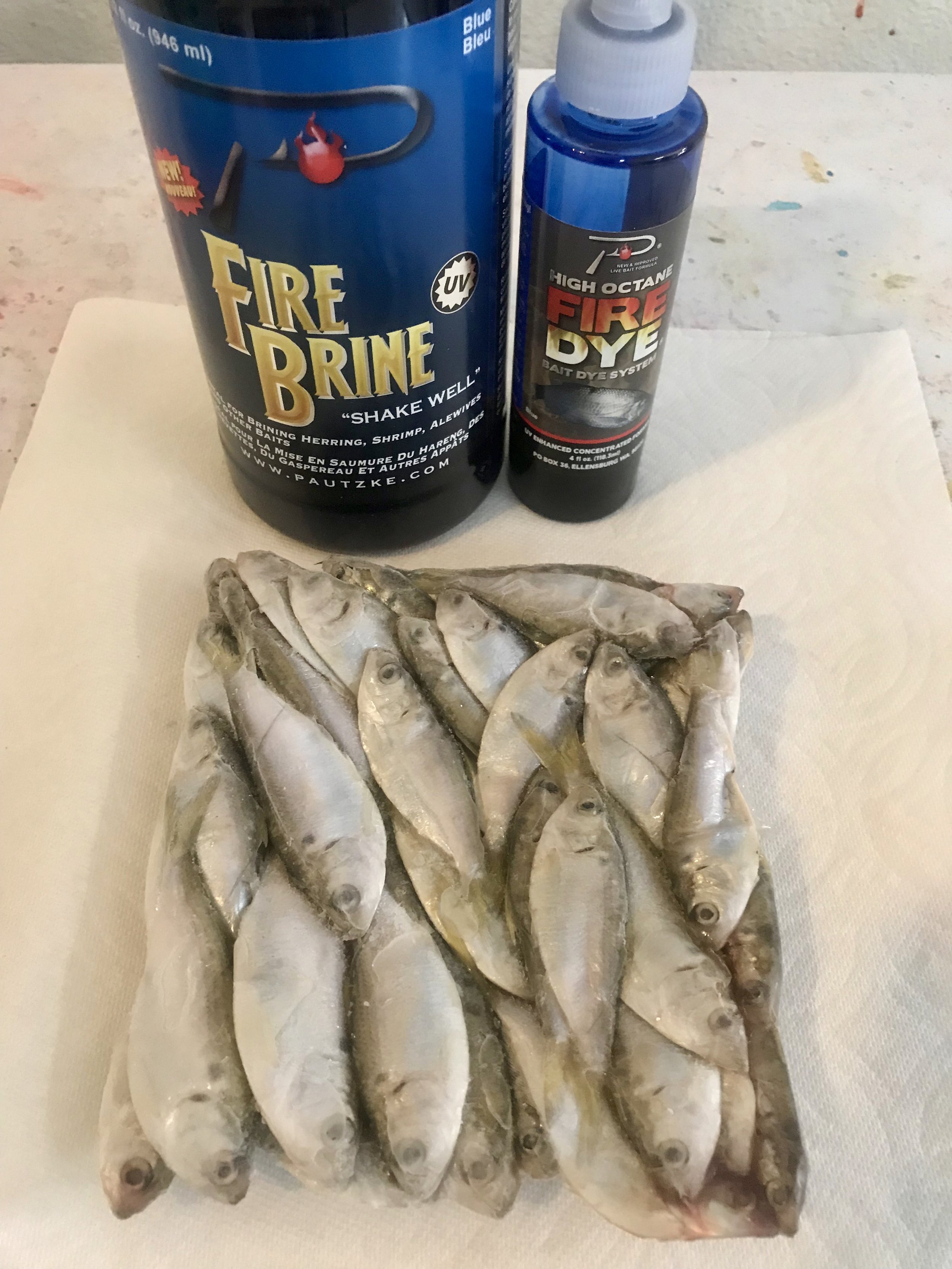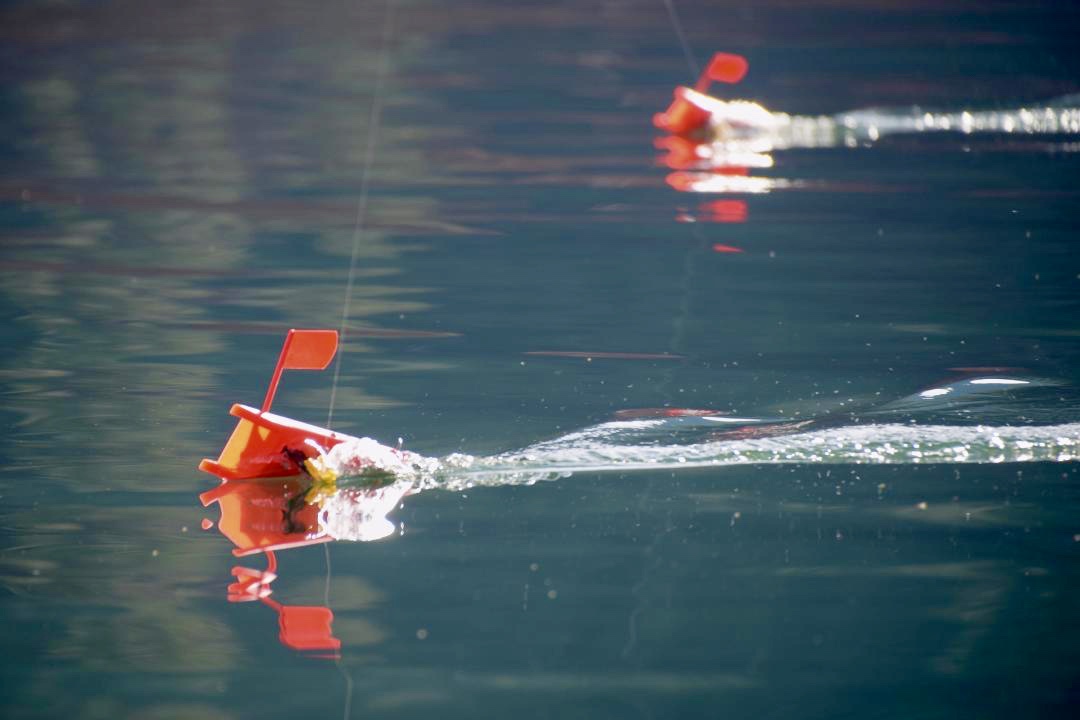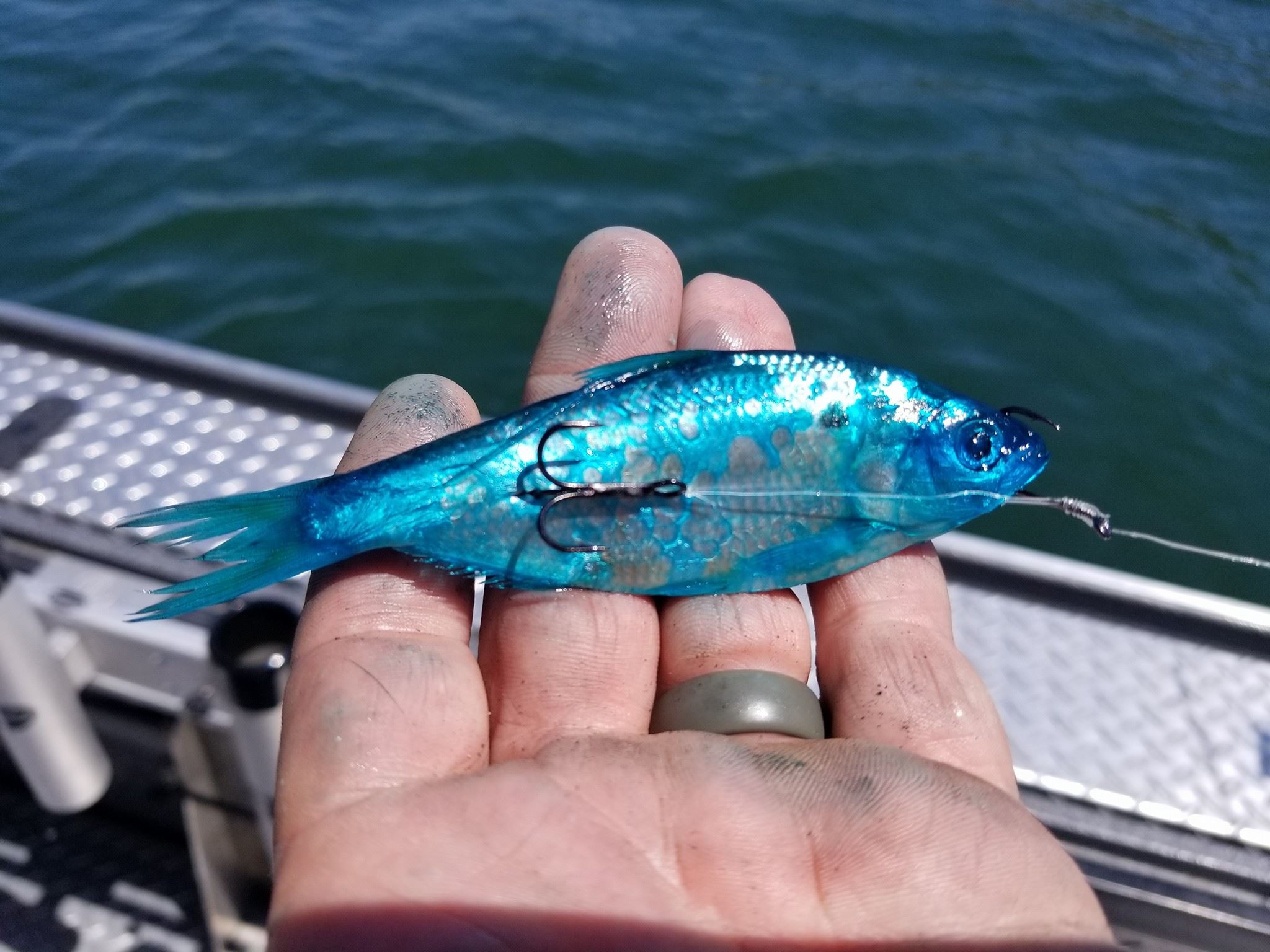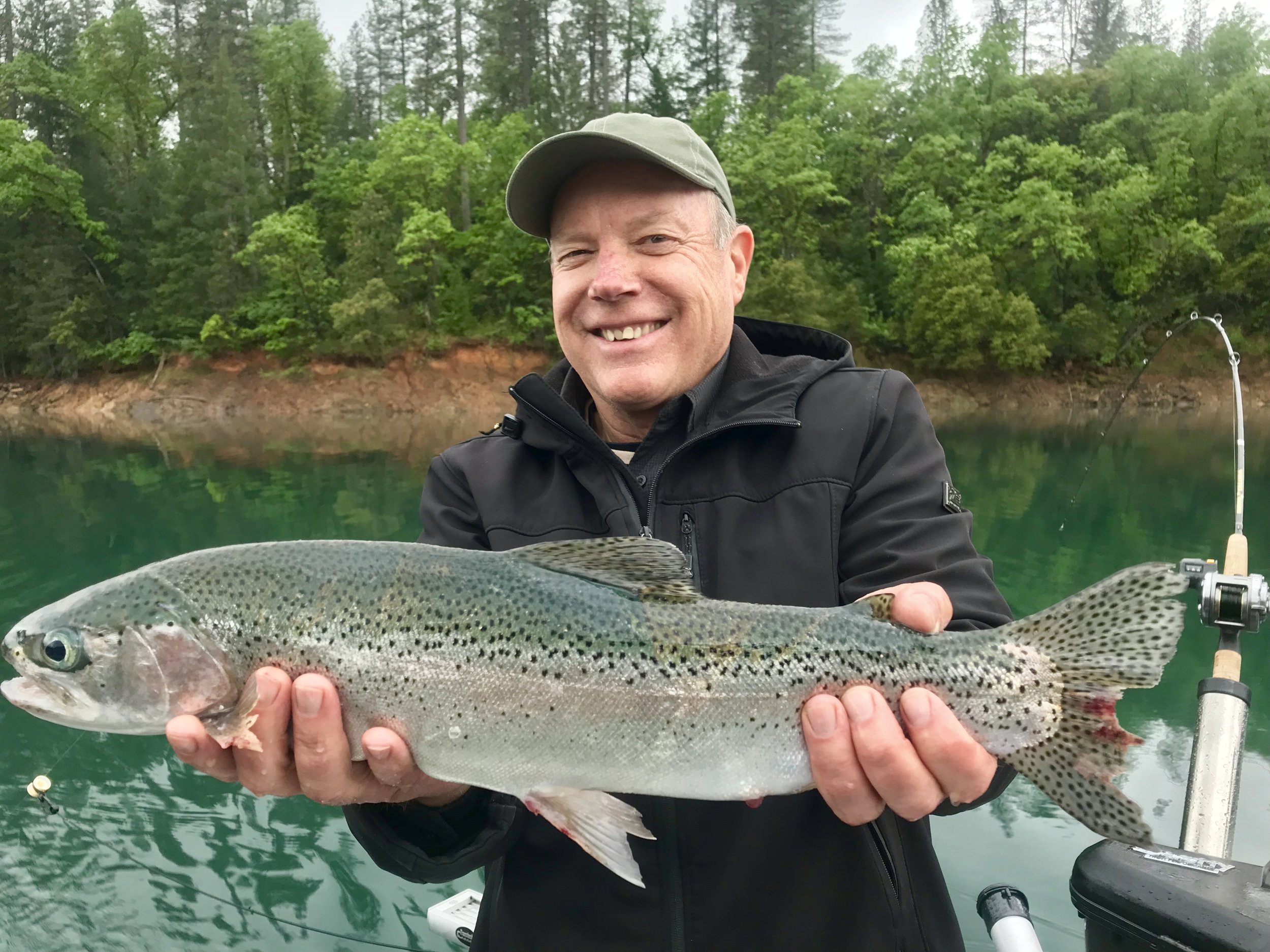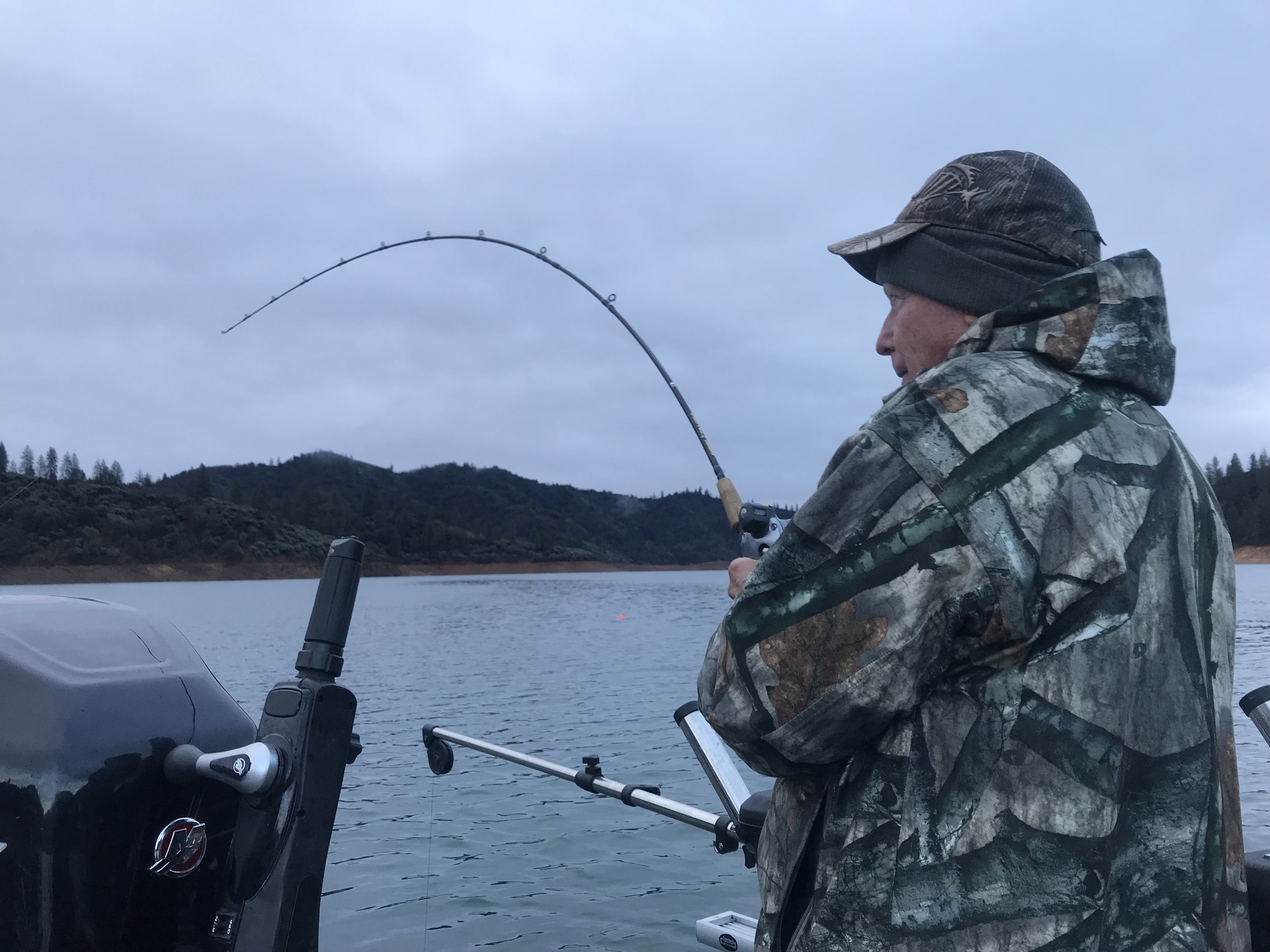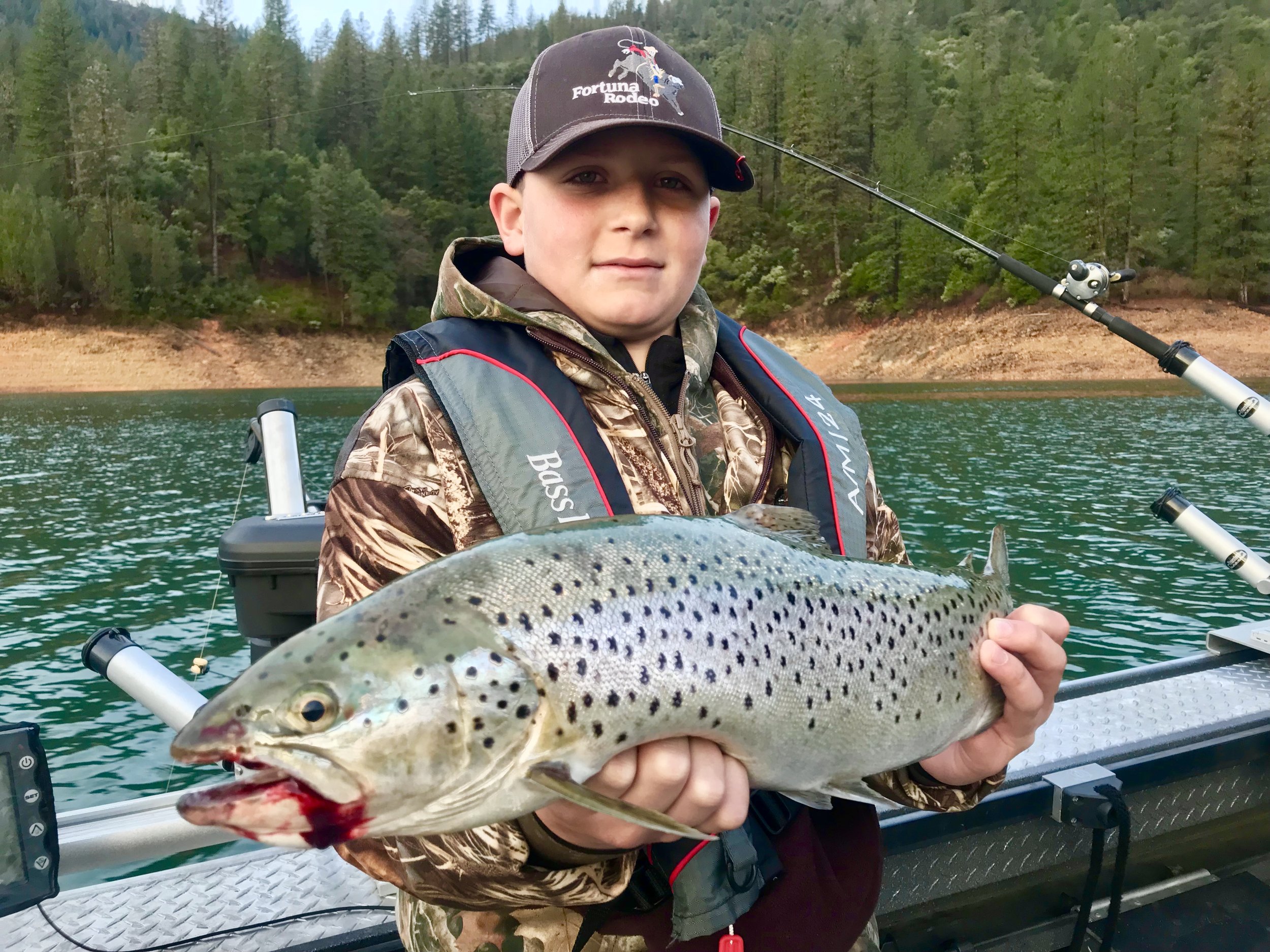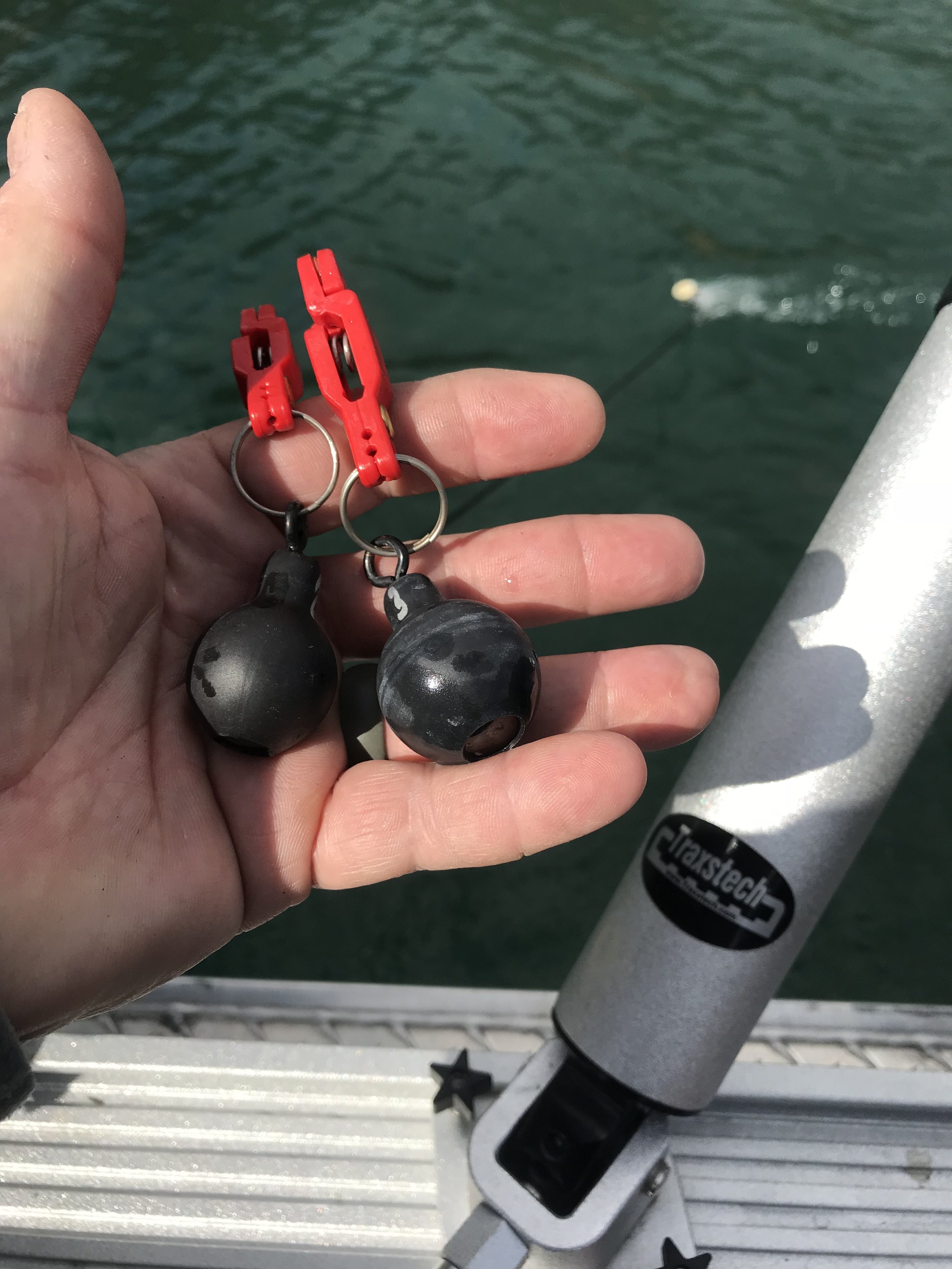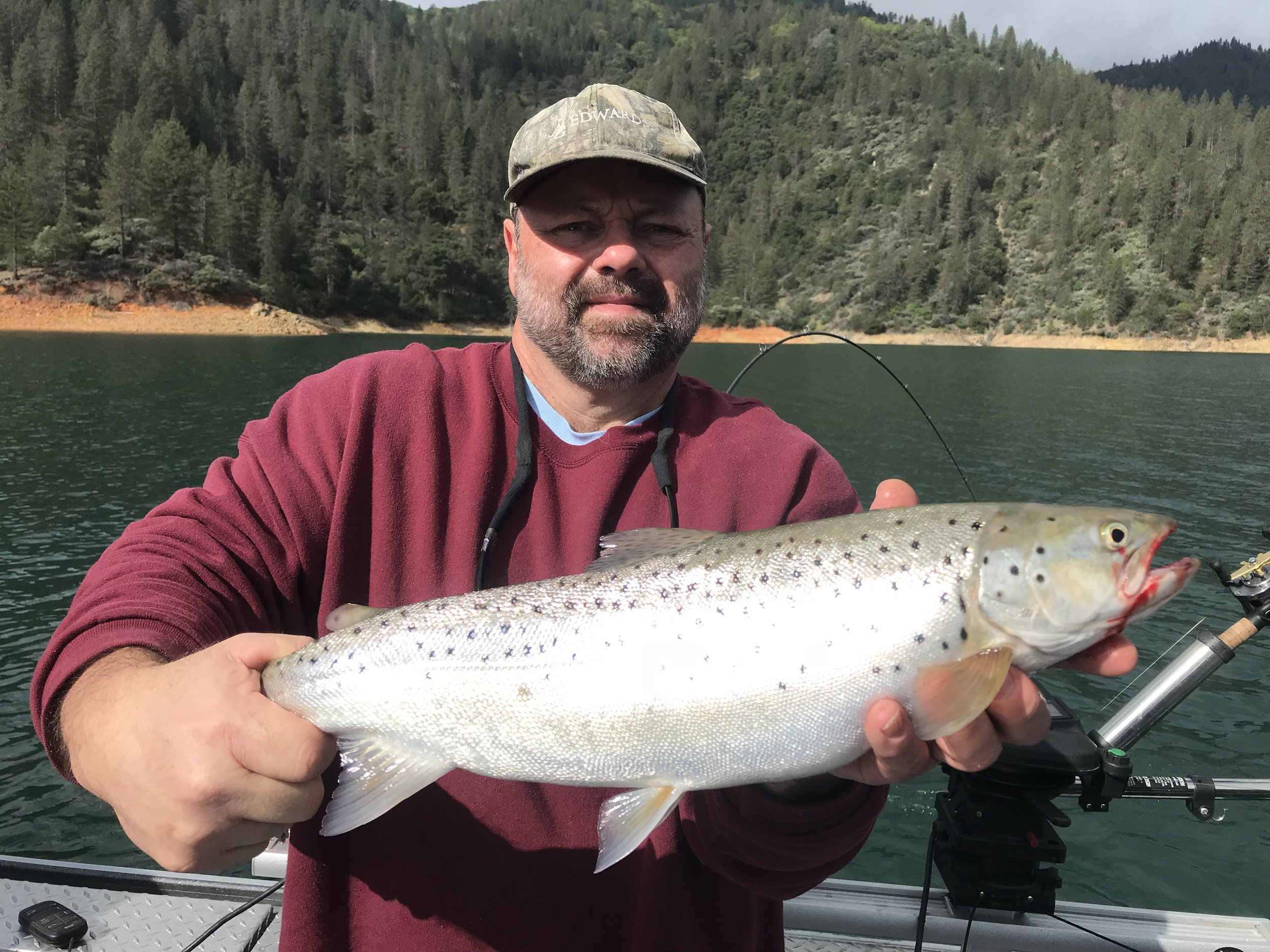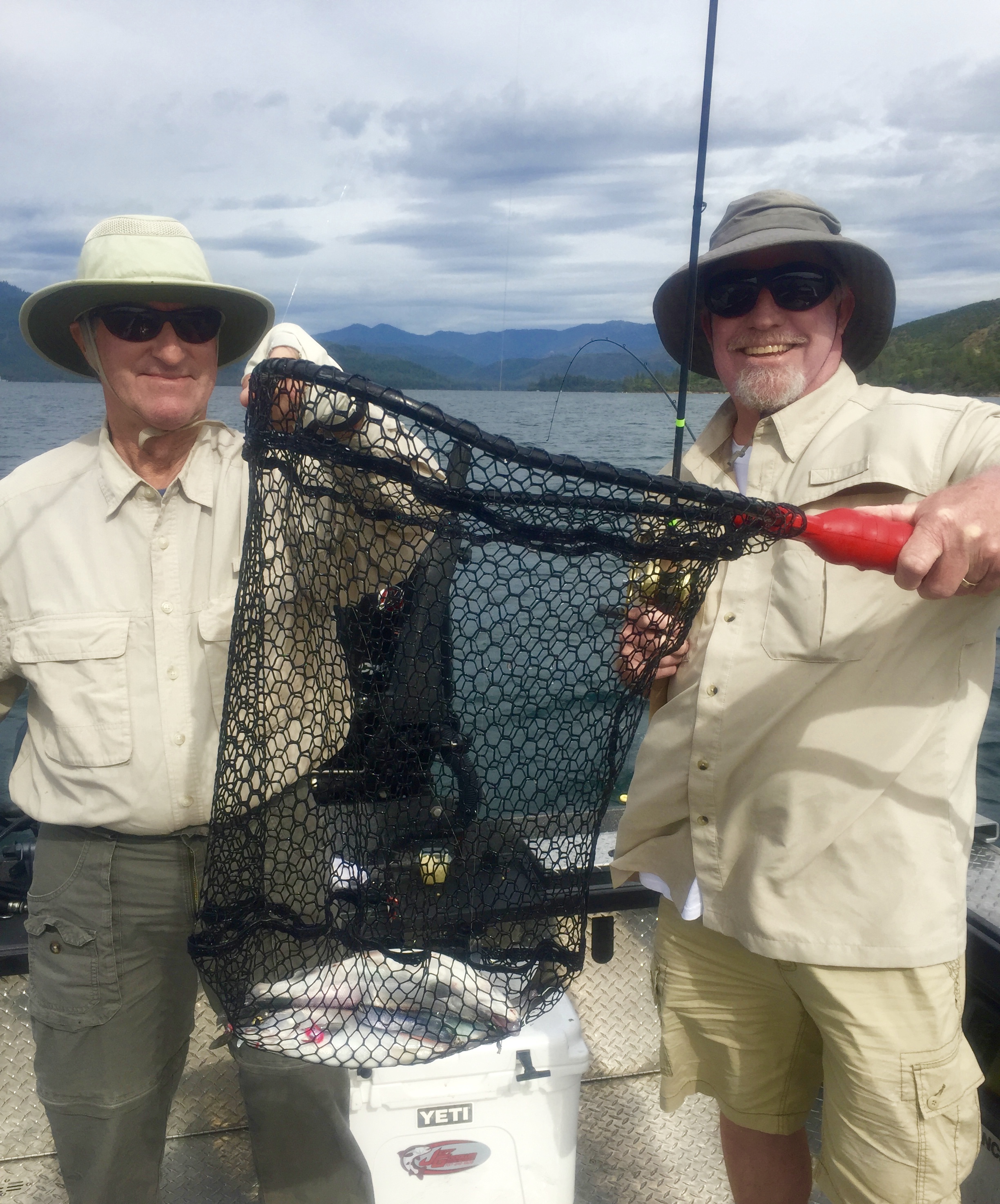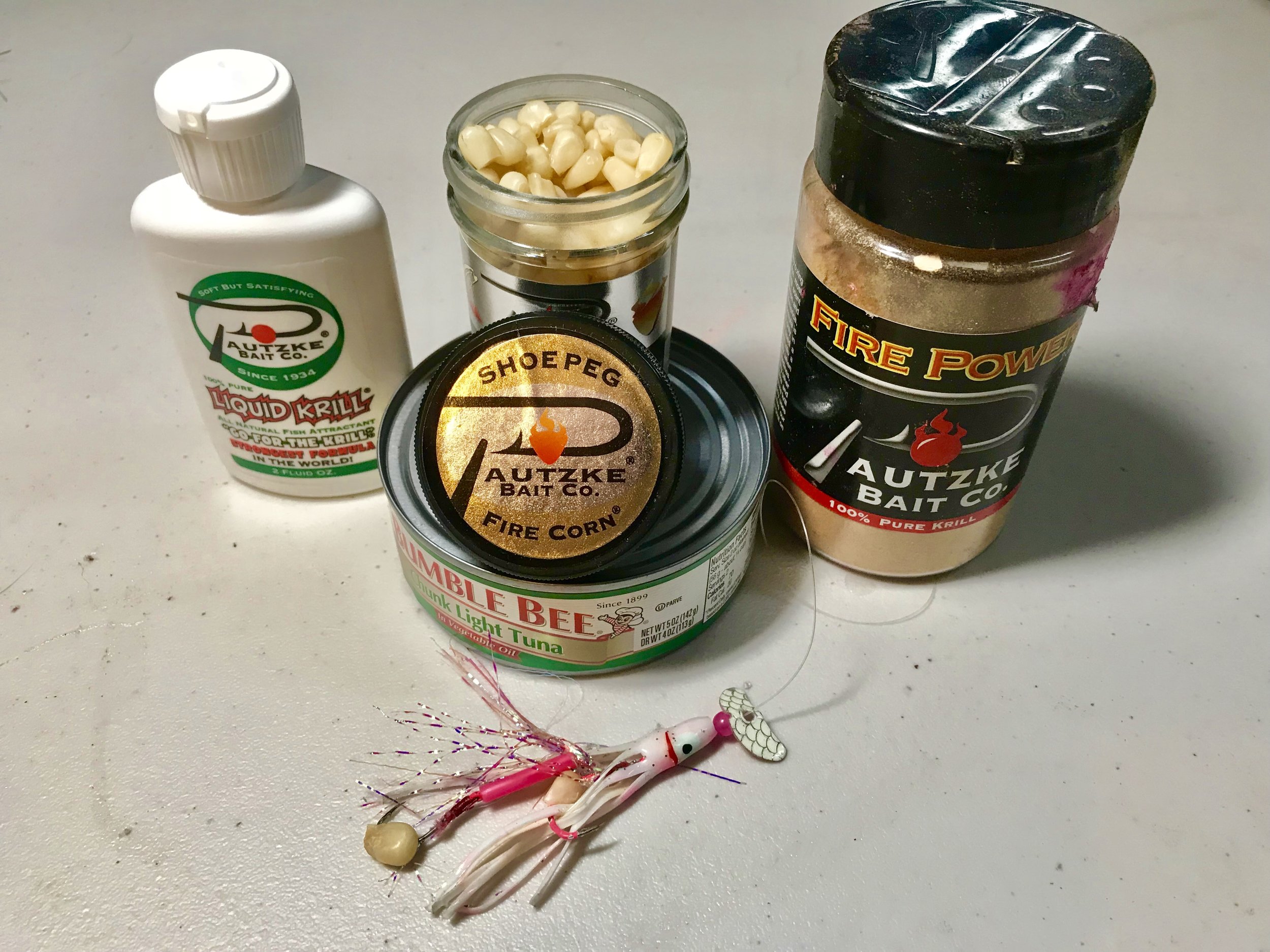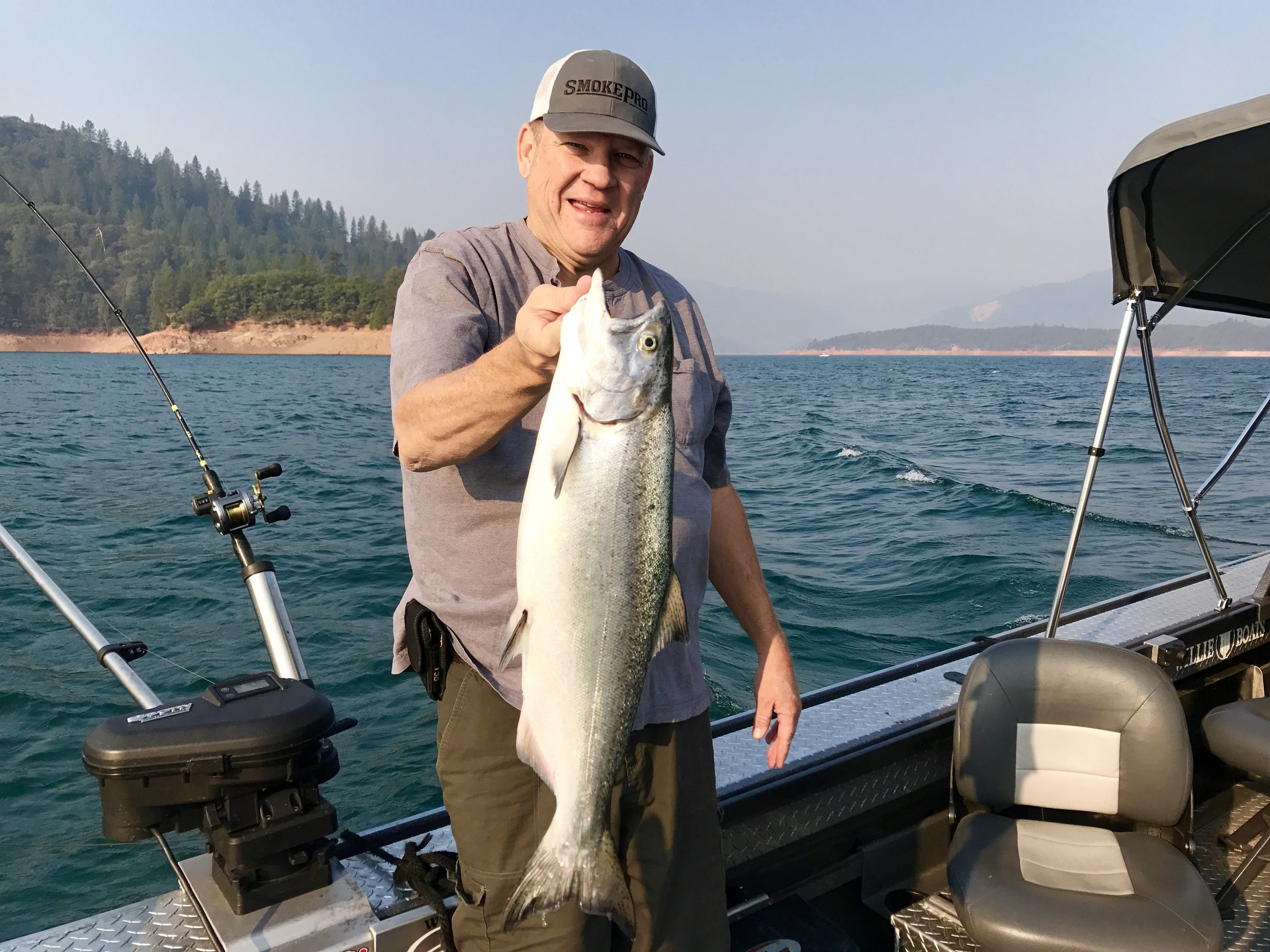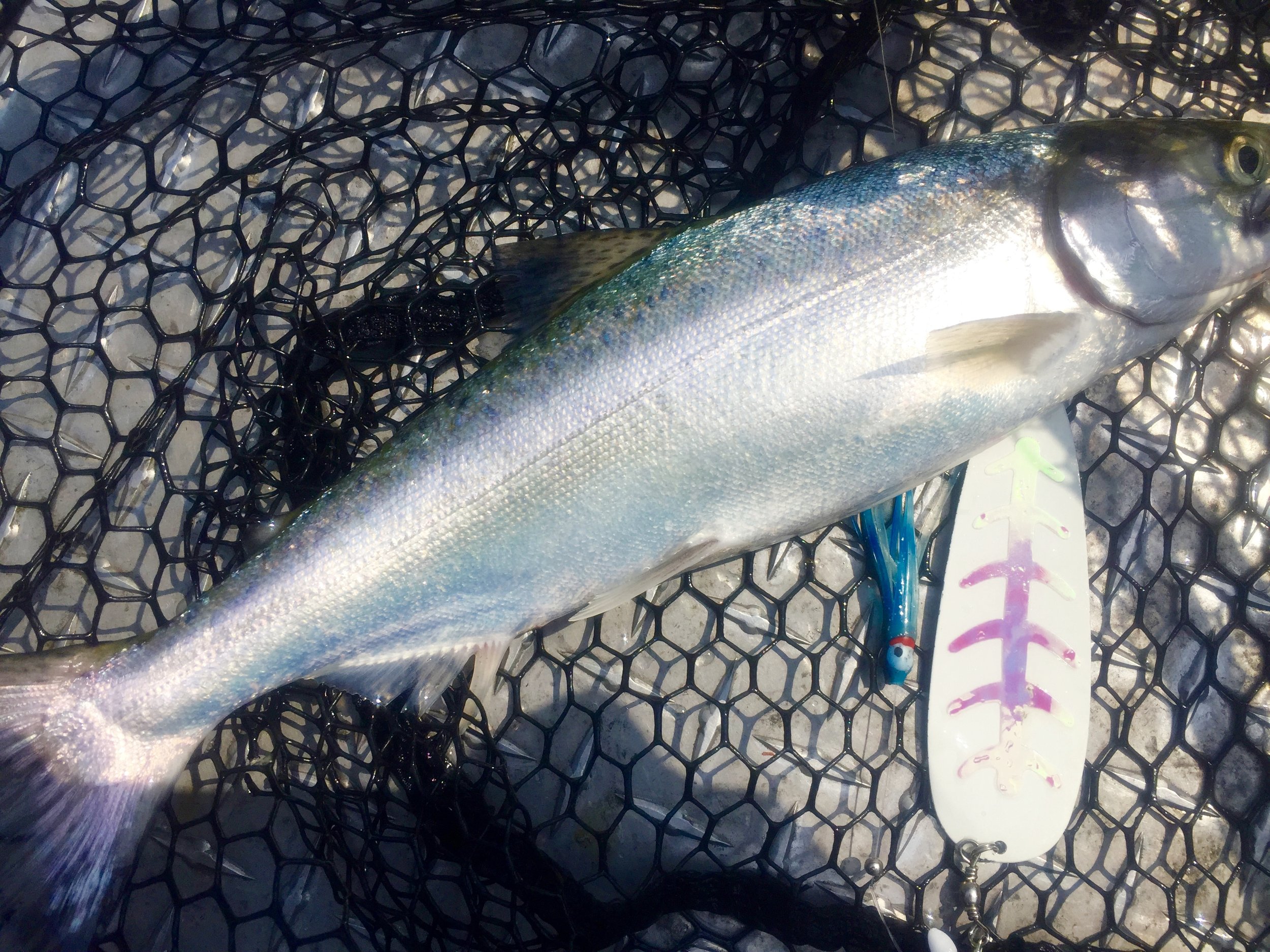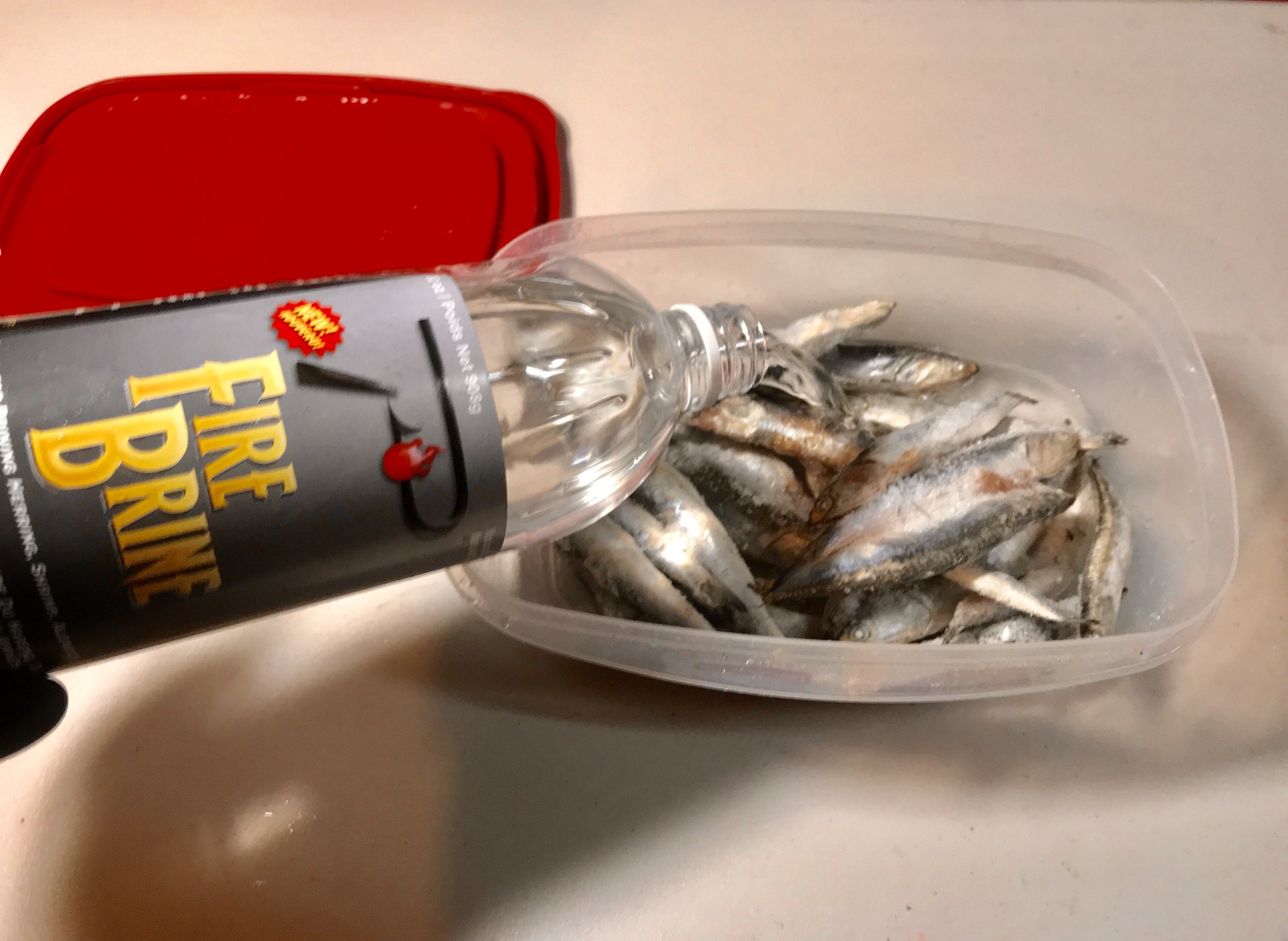FISHING SHASTA LAKE DURING THE MONTH OF MARCH
2021 Shasta Lake brown trout caught in March on the McCloud arm near Shasta Caverns
There are many techniques used to troll on Shasta Lake in the spring, but I favor trolling in the upper 20’ feet of the water column in March every year. Often times, I’ll leave the down riggers at home because I won’t even use them during the early spring months. Trolling with side planers with 1-3 ounces of snap weights will get your presentations into the depth range we typically see the trout holding in the spring. When trolling from a boat, pick areas likely to hold big browns and rainbows, and keep your lures as far away from the boat as reasonable to keep from spooking the bigger, more weary fish when trolling so high up in the water column. Big fish are definitely boat shy at times and so are the smaller trout for that matter.
One of our top techniques for finding and catching big trout on Shasta Lake during the early part of spring is the use of inline side planers with no weight at all. Top lining the surface and having different length setbacks can be absolutely deadly most days during early spring. There are times when big, aggressive brown trout will be attracted to the disturbed water from your trolling motor (prop water) and will come up to hit lures trolled in this piece of water close to and behind the boat. I’ll run a tail gunner rod straight out the back with 2-3 ounces of lead to be sure to get down quickly and to ensure that line won’t be a problem when bringing other fish to the back of he boat. You can use any number of ways to get the lines down a bit deeper straight behind the boat, but this technique is where snap weights or Torpedo weights will shine. I personally don’t like to drag downrigger cables and balls through this water.
LURES WE USE FOR TROUT IN MARCH
Brad’s Super Baits are big trout lures on Shasta Lake.
There are lots of flies, lures, and bait you can use to catch March trout on Shasta Lake, but if I had to choose only a few, one would be a Trinidad Tackle Optimizer or Optimizer Jr. spoon. Its been proven time and time again that these spoons will catch big Shasta Lake trout, especially big browns. Another is the Brad’s Kokanee Cut Plugs which have an option to stuff them with bait and that has its advantages. I started using the KCP’s a lot last year in the spring and summer, and after some trial and error, I started catching some amazing trout. It should be noted that some days, the Brad’s KCP’s will out fish every lure in the boat. They are also a favorite for catching Kings on Shasta, but I’ll talk more about how I fish them a little closer to spring when we start to target King and Kokanee salmon. I also spent some time in 2021 experimenting with Brad’s original Super Baits and they are also big brown trout lures and will catch big Shasta Lake Kings later in the spring as well. I mainly focused on the natural Super Bait bait colors, but I’ll be trying some of the brighter colors in 2022 for sure. Don’t forget to stuff their bait cavities with your favorite Pautzke Fire Gel scents or chopped up canned or natural frozen baits.
Last but not least, I have previously written an article surrounding the use of trolling flies for trout on Shasta Lake and its had thousands of readers since I wrote it a few years ago. Flies are deadly when trolling for trout on Shasta so taking the time to read that article is very much worth your time. Flies can be trolled with any other presentation at the same time which makes them one of the most versatile attractors for trout known to mankind. Flies are especially effective when fishing in bright sunlight and calm surface conditions. Flies presented with finesse during blue bird days seems to be one way to get a bite going when nothing else will work.
WHERE TO FISH ON SHASTA LAKE IN MARCH
Big trout arches on the McCloud arm of Shasta Lake in March. These big fish can be a tough nut to crack when they are deep, but when they come up looking for a meal, its game on!
Trout fishing on Shasta Lake in march can be fairly tough, and most of that tough fishing comes when we’re seeing continuous pressure changes due to the stormy weather patterns. Staying on top of the fishing pattern is pretty important and that means spending a lot of days on the water figuring out where the trout are hanging out. Rainbow trout, unlike the brown trout, will be found in certain areas of the lake for a short period of time, but will often move around to other parts of the lake without proper notice to the anglers that pursue them. This can be very frustrating and can sometimes have you second guessing yourself for days on end. I will almost always look for the browns and rainbows that are in the lake in March to be located higher in the lake arms. The browns have come back into the lake after spawning and the rainbows are on their way up to start their spring spawning ritual. The limits for me at the top of the arms are generally where water below 48 degrees begins. Its not often I find a good trout bite on Shasta Lake when the water temps are cooler than 48 degrees.
Two patterns that the trout in Shasta Lake seem to stay true to is, browns hold on or near structure most of the time, and rainbows will hold shallow over the deeper sections (channels) of the lake. Browns are territorial to specific areas of the lake and rainbows, are definitely nomadic. As always, browns and rainbows are going to be near some baitfish if you can find some during the early spring months. Trolling side planers is a great way to cover the areas that browns will hold close to shore, and even over the deeper water sections of the lake. Its hard to beat this technique for covering large sections of the water surface that will hold two different trout species simultaneously. Be prepared to cover a lot of structure and open water to catch trout on Shasta Lake during the early spring months.
FINAL THOUGHTS FOR FISHING SHASTA LAKE IN MARCH
I know this information will be helpful to some and I truly hope to see some of this information I’ve offered up put to use by the readers of this article. It doesn’t contain every piece of the puzzle, but the puzzle pieces change every month of the year. Some of the biggest trout, especially brown trout, are caught during March every spring season and this year will be no exception. I’m still looking to beat the boat record which was a 10.5 lbs. brown 3 years ago but I haven’t been able to land one just yet. I guarantee there are browns in Shasta over 20 lbs. and someday I’ll prove it. I wish all of you the best of luck in the 2022 season and hope to see some giant Shasta Lake trout pic’s again this year.
My next article will contain a few different tactics on how to fish Shasta Lake during the month of April, the most difficult month to fish Shasta Lake. Unlike March, April will bring some major changes to Shasta Lake and my methods of fishing it will change considerably. It’s not a month I get very excited about to be honest, but that never stops me from trying and nor should it you!
Captain Jeff Goodwin

